| schema location: | C:\m2mmc\branches\4.7.0\win\unified-web-service\APIs\v2\Schema\DeviceService.xsd |
| attributeFormDefault: | |
| elementFormDefault: | qualified |
| targetNamespace: | http://nphase.com/unifiedwebservice/v2 |
| schema location: | C:\m2mmc\branches\4.7.0\win\unified-web-service\APIs\v2\Schema\Types\DeviceServiceTypes.xsd |
| attributeFormDefault: | |
| elementFormDefault: | qualified |
| targetNamespace: | http://nphase.com/unifiedwebservice/v2 |
| Complex types |
| CarrierInformation |
| ConnectionEventAttribute |
| CustomFieldObj |
| DeviceCapability |
| DeviceConnectionEvent |
| DeviceInformation |
| DeviceUsage |
| Messages |
| ProvisioningEvent |
| schema location: | C:\m2mmc\branches\4.7.0\win\unified-web-service\APIs\v2\Schema\Types\Common\CommonTypes.xsd |
| attributeFormDefault: | |
| elementFormDefault: | qualified |
| targetNamespace: | http://nphase.com/unifiedwebservice/v2 |
element AddDevicesRequest
| diagram | 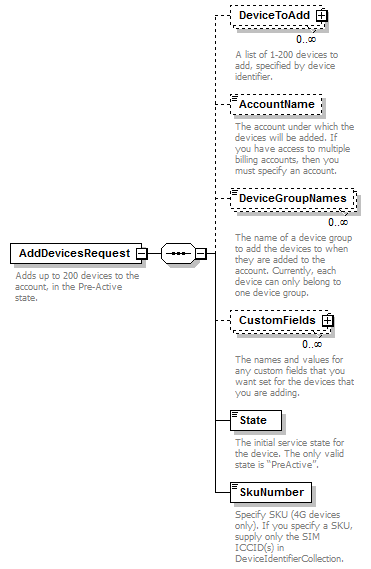 |
||
| namespace | http://nphase.com/unifiedwebservice/v2 | ||
| properties |
|
||
| children | DeviceToAdd AccountName DeviceGroupNames CustomFields State SkuNumber | ||
| annotation |
|
||
| source | <xs:element name="AddDevicesRequest"> <xs:annotation> <xs:documentation>Adds up to 200 devices to the account, in the Pre-Active state.</xs:documentation> </xs:annotation> <xs:complexType> <xs:sequence> <xs:element name="DeviceToAdd" type="DeviceIdentifierCollection" nillable="true" minOccurs="0" maxOccurs="unbounded"> <xs:annotation> <xs:documentation>A list of 1-200 devices to add, specified by device identifier.</xs:documentation> </xs:annotation> </xs:element> <xs:element name="AccountName" type="xs:string" nillable="true" minOccurs="0"> <xs:annotation> <xs:documentation>The account under which the devices will be added. If you have access to multiple billing accounts, then you must specify an account.</xs:documentation> </xs:annotation> </xs:element> <xs:element name="DeviceGroupNames" type="xs:string" nillable="true" minOccurs="0" maxOccurs="unbounded"> <xs:annotation> <xs:documentation>The name of a device group to add the devices to when they are added to the account. Currently, each device can only belong to one device group.</xs:documentation> </xs:annotation> </xs:element> <xs:element name="CustomFields" type="CustomFieldObj" nillable="true" minOccurs="0" maxOccurs="unbounded"> <xs:annotation> <xs:documentation>The names and values for any custom fields that you want set for the devices that you are adding.</xs:documentation> </xs:annotation> </xs:element> <xs:element name="State" type="xs:string" nillable="false"> <xs:annotation> <xs:documentation>The initial service state for the device. The only valid state is “PreActive”.</xs:documentation> </xs:annotation> </xs:element> <xs:element name="SkuNumber" type="xs:string" nillable="true"> <xs:annotation> <xs:documentation>Specify SKU (4G devices only). If you specify a SKU, supply only the SIM ICCID(s) in DeviceIdentifierCollection.</xs:documentation> </xs:annotation> </xs:element> </xs:sequence> </xs:complexType> </xs:element> |
element AddDevicesRequest/DeviceToAdd
| diagram |  |
||||||||
| namespace | http://nphase.com/unifiedwebservice/v2 | ||||||||
| type | DeviceIdentifierCollection | ||||||||
| properties |
|
||||||||
| children | DeviceIdentifiers | ||||||||
| annotation |
|
||||||||
| source | <xs:element name="DeviceToAdd" type="DeviceIdentifierCollection" nillable="true" minOccurs="0" maxOccurs="unbounded"> <xs:annotation> <xs:documentation>A list of 1-200 devices to add, specified by device identifier.</xs:documentation> </xs:annotation> </xs:element> |
element AddDevicesRequest/AccountName
| diagram |  |
||||||||
| namespace | http://nphase.com/unifiedwebservice/v2 | ||||||||
| type | xs:string | ||||||||
| properties |
|
||||||||
| annotation |
|
||||||||
| source | <xs:element name="AccountName" type="xs:string" nillable="true" minOccurs="0"> <xs:annotation> <xs:documentation>The account under which the devices will be added. If you have access to multiple billing accounts, then you must specify an account.</xs:documentation> </xs:annotation> </xs:element> |
element AddDevicesRequest/DeviceGroupNames
| diagram | 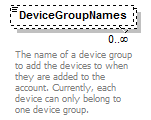 |
||||||||
| namespace | http://nphase.com/unifiedwebservice/v2 | ||||||||
| type | xs:string | ||||||||
| properties |
|
||||||||
| annotation |
|
||||||||
| source | <xs:element name="DeviceGroupNames" type="xs:string" nillable="true" minOccurs="0" maxOccurs="unbounded"> <xs:annotation> <xs:documentation>The name of a device group to add the devices to when they are added to the account. Currently, each device can only belong to one device group.</xs:documentation> </xs:annotation> </xs:element> |
element AddDevicesRequest/CustomFields
| diagram | 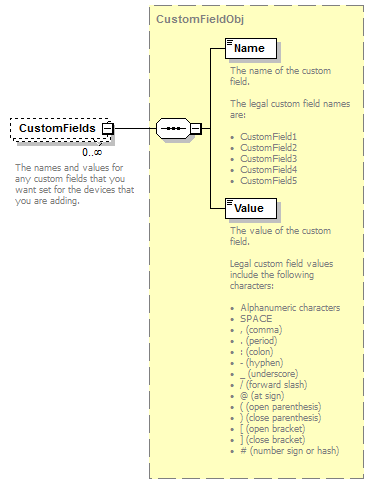 |
||||||||
| namespace | http://nphase.com/unifiedwebservice/v2 | ||||||||
| type | CustomFieldObj | ||||||||
| properties |
|
||||||||
| children | Name Value | ||||||||
| annotation |
|
||||||||
| source | <xs:element name="CustomFields" type="CustomFieldObj" nillable="true" minOccurs="0" maxOccurs="unbounded"> <xs:annotation> <xs:documentation>The names and values for any custom fields that you want set for the devices that you are adding.</xs:documentation> </xs:annotation> </xs:element> |
element AddDevicesRequest/State
| diagram |  |
||||
| namespace | http://nphase.com/unifiedwebservice/v2 | ||||
| type | xs:string | ||||
| properties |
|
||||
| annotation |
|
||||
| source | <xs:element name="State" type="xs:string" nillable="false"> <xs:annotation> <xs:documentation>The initial service state for the device. The only valid state is “PreActive”.</xs:documentation> </xs:annotation> </xs:element> |
element AddDevicesRequest/SkuNumber
| diagram |  |
||||
| namespace | http://nphase.com/unifiedwebservice/v2 | ||||
| type | xs:string | ||||
| properties |
|
||||
| annotation |
|
||||
| source | <xs:element name="SkuNumber" type="xs:string" nillable="true"> <xs:annotation> <xs:documentation>Specify SKU (4G devices only). If you specify a SKU, supply only the SIM ICCID(s) in DeviceIdentifierCollection.</xs:documentation> </xs:annotation> </xs:element> |
element AddDevicesResponse
| diagram | 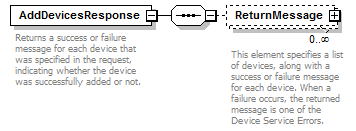 |
||
| namespace | http://nphase.com/unifiedwebservice/v2 | ||
| properties |
|
||
| children | ReturnMessage | ||
| annotation |
|
||
| source | <xs:element name="AddDevicesResponse"> <xs:annotation> <xs:documentation>Returns a success or failure message for each device that was specified in the request, indicating whether the device was successfully added or not.</xs:documentation> </xs:annotation> <xs:complexType> <xs:sequence> <xs:element name="ReturnMessage" type="Messages" nillable="true" minOccurs="0" maxOccurs="unbounded"> <xs:annotation> <xs:documentation>This element specifies a list of devices, along with a success or failure message for each device. When a failure occurs, the returned message is one of the Device Service Errors. </xs:documentation> </xs:annotation> </xs:element> </xs:sequence> </xs:complexType> </xs:element> |
element AddDevicesResponse/ReturnMessage
| diagram | 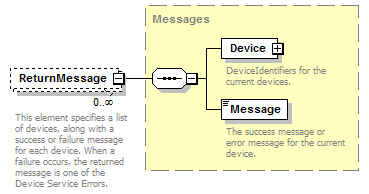 |
||||||||
| namespace | http://nphase.com/unifiedwebservice/v2 | ||||||||
| type | Messages | ||||||||
| properties |
|
||||||||
| children | Device Message | ||||||||
| annotation |
|
||||||||
| source | <xs:element name="ReturnMessage" type="Messages" nillable="true" minOccurs="0" maxOccurs="unbounded"> <xs:annotation> <xs:documentation>This element specifies a list of devices, along with a success or failure message for each device. When a failure occurs, the returned message is one of the Device Service Errors. </xs:documentation> </xs:annotation> </xs:element> |
element GetAggregateDeviceUsageRequest
| diagram | 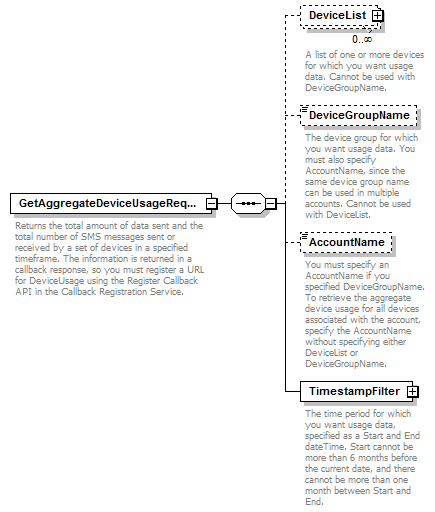 |
||
| namespace | http://nphase.com/unifiedwebservice/v2 | ||
| properties |
|
||
| children | DeviceList DeviceGroupName AccountName TimestampFilter | ||
| annotation |
|
||
| source | <xs:element name="GetAggregateDeviceUsageRequest"> <xs:annotation> <xs:documentation>Returns the total amount of data sent and the total number of SMS messages sent or received by a set of devices in a specified timeframe. The information is returned in a callback response, so you must register a URL for DeviceUsage using the Register Callback API in the Callback Registration Service. </xs:documentation> </xs:annotation> <xs:complexType> <xs:sequence> <xs:element name="DeviceList" type="DeviceIdentifier" nillable="true" minOccurs="0" maxOccurs="unbounded"> <xs:annotation> <xs:documentation>A list of one or more devices for which you want usage data. Cannot be used with DeviceGroupName.</xs:documentation> </xs:annotation> </xs:element> <xs:element name="DeviceGroupName" type="xs:string" nillable="true" minOccurs="0"> <xs:annotation> <xs:documentation>The device group for which you want usage data. You must also specify AccountName, since the same device group name can be used in multiple accounts. Cannot be used with DeviceList.</xs:documentation> </xs:annotation> </xs:element> <xs:element name="AccountName" type="xs:string" minOccurs="0"> <xs:annotation> <xs:documentation>You must specify an AccountName if you specified DeviceGroupName. To retrieve the aggregate device usage for all devices associated with the account, specify the AccountName without specifying either DeviceList or DeviceGroupName.</xs:documentation> </xs:annotation> </xs:element> <xs:element name="TimestampFilter" type="TimeRange"> <xs:annotation> <xs:documentation>The time period for which you want usage data, specified as a Start and End dateTime. Start cannot be more than 6 months before the current date, and there cannot be more than one month between Start and End. </xs:documentation> </xs:annotation> </xs:element> </xs:sequence> </xs:complexType> </xs:element> |
element GetAggregateDeviceUsageRequest/DeviceList
| diagram | 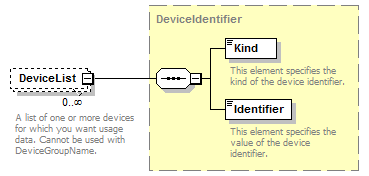 |
||||||||
| namespace | http://nphase.com/unifiedwebservice/v2 | ||||||||
| type | DeviceIdentifier | ||||||||
| properties |
|
||||||||
| children | Kind Identifier | ||||||||
| annotation |
|
||||||||
| source | <xs:element name="DeviceList" type="DeviceIdentifier" nillable="true" minOccurs="0" maxOccurs="unbounded"> <xs:annotation> <xs:documentation>A list of one or more devices for which you want usage data. Cannot be used with DeviceGroupName.</xs:documentation> </xs:annotation> </xs:element> |
element GetAggregateDeviceUsageRequest/DeviceGroupName
| diagram | 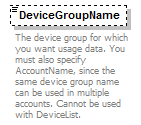 |
||||||||
| namespace | http://nphase.com/unifiedwebservice/v2 | ||||||||
| type | xs:string | ||||||||
| properties |
|
||||||||
| annotation |
|
||||||||
| source | <xs:element name="DeviceGroupName" type="xs:string" nillable="true" minOccurs="0"> <xs:annotation> <xs:documentation>The device group for which you want usage data. You must also specify AccountName, since the same device group name can be used in multiple accounts. Cannot be used with DeviceList.</xs:documentation> </xs:annotation> </xs:element> |
element GetAggregateDeviceUsageRequest/AccountName
| diagram | 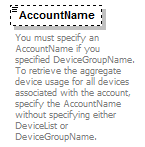 |
||||||
| namespace | http://nphase.com/unifiedwebservice/v2 | ||||||
| type | xs:string | ||||||
| properties |
|
||||||
| annotation |
|
||||||
| source | <xs:element name="AccountName" type="xs:string" minOccurs="0"> <xs:annotation> <xs:documentation>You must specify an AccountName if you specified DeviceGroupName. To retrieve the aggregate device usage for all devices associated with the account, specify the AccountName without specifying either DeviceList or DeviceGroupName.</xs:documentation> </xs:annotation> </xs:element> |
element GetAggregateDeviceUsageRequest/TimestampFilter
| diagram | 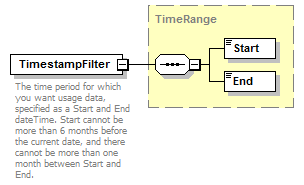 |
||
| namespace | http://nphase.com/unifiedwebservice/v2 | ||
| type | TimeRange | ||
| properties |
|
||
| children | Start End | ||
| annotation |
|
||
| source | <xs:element name="TimestampFilter" type="TimeRange"> <xs:annotation> <xs:documentation>The time period for which you want usage data, specified as a Start and End dateTime. Start cannot be more than 6 months before the current date, and there cannot be more than one month between Start and End. </xs:documentation> </xs:annotation> </xs:element> |
element GetAggregateDeviceUsageResponse
| diagram |  |
||
| namespace | http://nphase.com/unifiedwebservice/v2 | ||
| properties |
|
||
| children | RequestId | ||
| annotation |
|
||
| source | <xs:element name="GetAggregateDeviceUsageResponse"> <xs:annotation> <xs:documentation>Returns a unique request ID if the request was successfully sent.</xs:documentation> </xs:annotation> <xs:complexType> <xs:sequence> <xs:element name="RequestId" type="xs:string"> <xs:annotation> <xs:documentation>A unique ID that associates the request with the results that are sent via a callback service.</xs:documentation> </xs:annotation> </xs:element> </xs:sequence> </xs:complexType> </xs:element> |
element GetAggregateDeviceUsageResponse/RequestId
| diagram |  |
||
| namespace | http://nphase.com/unifiedwebservice/v2 | ||
| type | xs:string | ||
| properties |
|
||
| annotation |
|
||
| source | <xs:element name="RequestId" type="xs:string"> <xs:annotation> <xs:documentation>A unique ID that associates the request with the results that are sent via a callback service.</xs:documentation> </xs:annotation> </xs:element> |
element GetDeviceCapabilitiesRequest
| diagram |  |
||
| namespace | http://nphase.com/unifiedwebservice/v2 | ||
| properties |
|
||
| children | Device | ||
| annotation |
|
||
| source | <xs:element name="GetDeviceCapabilitiesRequest"> <xs:annotation> <xs:documentation>This API is no longer supported.</xs:documentation> </xs:annotation> <xs:complexType> <xs:sequence> <xs:element name="Device" type="DeviceIdentifier"/> </xs:sequence> </xs:complexType> </xs:element> |
element GetDeviceCapabilitiesRequest/Device
| diagram | 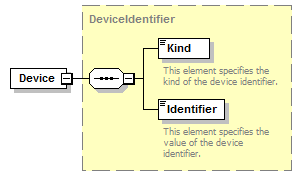 |
||
| namespace | http://nphase.com/unifiedwebservice/v2 | ||
| type | DeviceIdentifier | ||
| properties |
|
||
| children | Kind Identifier | ||
| source | <xs:element name="Device" type="DeviceIdentifier"/> |
element GetDeviceCapabilitiesResponse
| diagram |  |
||
| namespace | http://nphase.com/unifiedwebservice/v2 | ||
| properties |
|
||
| children | Capabilities | ||
| source | <xs:element name="GetDeviceCapabilitiesResponse"> <xs:complexType> <xs:sequence> <xs:element name="Capabilities" type="DeviceCapability" nillable="true" minOccurs="0" maxOccurs="unbounded"/> </xs:sequence> </xs:complexType> </xs:element> |
element GetDeviceCapabilitiesResponse/Capabilities
| diagram | 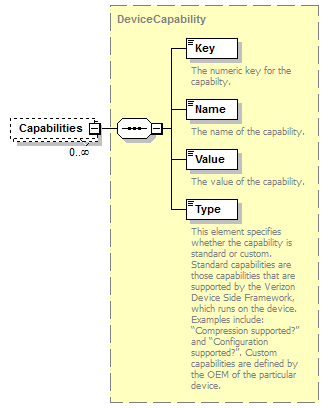 |
||||||||
| namespace | http://nphase.com/unifiedwebservice/v2 | ||||||||
| type | DeviceCapability | ||||||||
| properties |
|
||||||||
| children | Key Name Value Type | ||||||||
| source | <xs:element name="Capabilities" type="DeviceCapability" nillable="true" minOccurs="0" maxOccurs="unbounded"/> |
element GetDeviceConnectionHistoryRequest
| diagram | 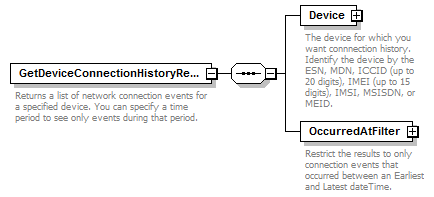 |
||
| namespace | http://nphase.com/unifiedwebservice/v2 | ||
| properties |
|
||
| children | Device OccurredAtFilter | ||
| annotation |
|
||
| source | <xs:element name="GetDeviceConnectionHistoryRequest"> <xs:annotation> <xs:documentation>Returns a list of network connection events for a specified device. You can specify a time period to see only events during that period.</xs:documentation> </xs:annotation> <xs:complexType> <xs:sequence> <xs:element name="Device" type="DeviceIdentifier"> <xs:annotation> <xs:documentation>The device for which you want connnection history. Identify the device by the ESN, MDN, ICCID (up to 20 digits), IMEI (up to 15 digits), IMSI, MSISDN, or MEID.</xs:documentation> </xs:annotation> </xs:element> <xs:element name="OccurredAtFilter" type="InclusiveDateTimeRange"> <xs:annotation> <xs:documentation>Restrict the results to only connection events that occurred between an Earliest and Latest dateTime.</xs:documentation> </xs:annotation> </xs:element> </xs:sequence> </xs:complexType> </xs:element> |
element GetDeviceConnectionHistoryRequest/Device
| diagram | 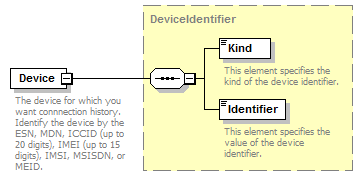 |
||
| namespace | http://nphase.com/unifiedwebservice/v2 | ||
| type | DeviceIdentifier | ||
| properties |
|
||
| children | Kind Identifier | ||
| annotation |
|
||
| source | <xs:element name="Device" type="DeviceIdentifier"> <xs:annotation> <xs:documentation>The device for which you want connnection history. Identify the device by the ESN, MDN, ICCID (up to 20 digits), IMEI (up to 15 digits), IMSI, MSISDN, or MEID.</xs:documentation> </xs:annotation> </xs:element> |
element GetDeviceConnectionHistoryRequest/OccurredAtFilter
| diagram | 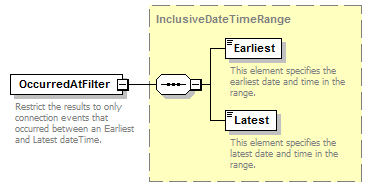 |
||
| namespace | http://nphase.com/unifiedwebservice/v2 | ||
| type | InclusiveDateTimeRange | ||
| properties |
|
||
| children | Earliest Latest | ||
| annotation |
|
||
| source | <xs:element name="OccurredAtFilter" type="InclusiveDateTimeRange"> <xs:annotation> <xs:documentation>Restrict the results to only connection events that occurred between an Earliest and Latest dateTime.</xs:documentation> </xs:annotation> </xs:element> |
element GetDeviceConnectionHistoryResponse
| diagram |  |
||
| namespace | http://nphase.com/unifiedwebservice/v2 | ||
| properties |
|
||
| children | Device ConnectionHistory IsComplete | ||
| annotation |
|
||
| source | <xs:element name="GetDeviceConnectionHistoryResponse"> <xs:annotation> <xs:documentation>The list of connection events for a device over a specified time range.</xs:documentation> </xs:annotation> <xs:complexType> <xs:sequence> <xs:element name="Device" type="DeviceIdentifier"> <xs:annotation> <xs:documentation>The device for which the connection history has been returned.</xs:documentation> </xs:annotation> </xs:element> <xs:element name="ConnectionHistory" type="DeviceConnectionEvent" nillable="true" minOccurs="0" maxOccurs="unbounded"> <xs:annotation> <xs:documentation>This element contains the connection history records.</xs:documentation> </xs:annotation> </xs:element> <xs:element name="IsComplete" type="xs:boolean"> <xs:annotation> <xs:documentation>This element indicates whether or not the response contains all records queried by the request. A maximum of 500 records are returned per call to this API. Retrieve more records by adjusting the OccurredAt filter in the request and calling this API again.</xs:documentation> </xs:annotation> </xs:element> </xs:sequence> </xs:complexType> </xs:element> |
element GetDeviceConnectionHistoryResponse/Device
| diagram | 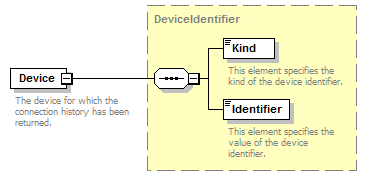 |
||
| namespace | http://nphase.com/unifiedwebservice/v2 | ||
| type | DeviceIdentifier | ||
| properties |
|
||
| children | Kind Identifier | ||
| annotation |
|
||
| source | <xs:element name="Device" type="DeviceIdentifier"> <xs:annotation> <xs:documentation>The device for which the connection history has been returned.</xs:documentation> </xs:annotation> </xs:element> |
element GetDeviceConnectionHistoryResponse/ConnectionHistory
| diagram | 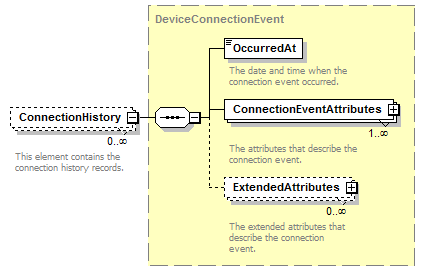 |
||||||||
| namespace | http://nphase.com/unifiedwebservice/v2 | ||||||||
| type | DeviceConnectionEvent | ||||||||
| properties |
|
||||||||
| children | OccurredAt ConnectionEventAttributes ExtendedAttributes | ||||||||
| annotation |
|
||||||||
| source | <xs:element name="ConnectionHistory" type="DeviceConnectionEvent" nillable="true" minOccurs="0" maxOccurs="unbounded"> <xs:annotation> <xs:documentation>This element contains the connection history records.</xs:documentation> </xs:annotation> </xs:element> |
element GetDeviceConnectionHistoryResponse/IsComplete
| diagram | 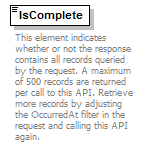 |
||
| namespace | http://nphase.com/unifiedwebservice/v2 | ||
| type | xs:boolean | ||
| properties |
|
||
| annotation |
|
||
| source | <xs:element name="IsComplete" type="xs:boolean"> <xs:annotation> <xs:documentation>This element indicates whether or not the response contains all records queried by the request. A maximum of 500 records are returned per call to this API. Retrieve more records by adjusting the OccurredAt filter in the request and calling this API again.</xs:documentation> </xs:annotation> </xs:element> |
element GetDeviceInformationRequest
| diagram |  |
||
| namespace | http://nphase.com/unifiedwebservice/v2 | ||
| properties |
|
||
| children | Device | ||
| annotation |
|
||
| source | <xs:element name="GetDeviceInformationRequest"> <xs:annotation> <xs:documentation>Returns information about a specified device, including its provisioning state, service plan, MDN, MIN, feature codes, IP address, and VPP lead information if applicable.</xs:documentation> </xs:annotation> <xs:complexType> <xs:sequence> <xs:element name="Device" type="DeviceIdentifier"> <xs:annotation> <xs:documentation>The device for which information will be returned.</xs:documentation> </xs:annotation> </xs:element> </xs:sequence> </xs:complexType> </xs:element> |
element GetDeviceInformationRequest/Device
| diagram |  |
||
| namespace | http://nphase.com/unifiedwebservice/v2 | ||
| type | DeviceIdentifier | ||
| properties |
|
||
| children | Kind Identifier | ||
| annotation |
|
||
| source | <xs:element name="Device" type="DeviceIdentifier"> <xs:annotation> <xs:documentation>The device for which information will be returned.</xs:documentation> </xs:annotation> </xs:element> |
element GetDeviceInformationResponse
| diagram |  |
||
| namespace | http://nphase.com/unifiedwebservice/v2 | ||
| properties |
|
||
| children | Device | ||
| annotation |
|
||
| source | <xs:element name="GetDeviceInformationResponse"> <xs:annotation> <xs:documentation>Returns device information for a specified device.</xs:documentation> </xs:annotation> <xs:complexType> <xs:sequence> <xs:element name="Device" type="DeviceInformation"> <xs:annotation> <xs:documentation>A list of information about the device.</xs:documentation> </xs:annotation> </xs:element> </xs:sequence> </xs:complexType> </xs:element> |
element GetDeviceInformationResponse/Device
| diagram | 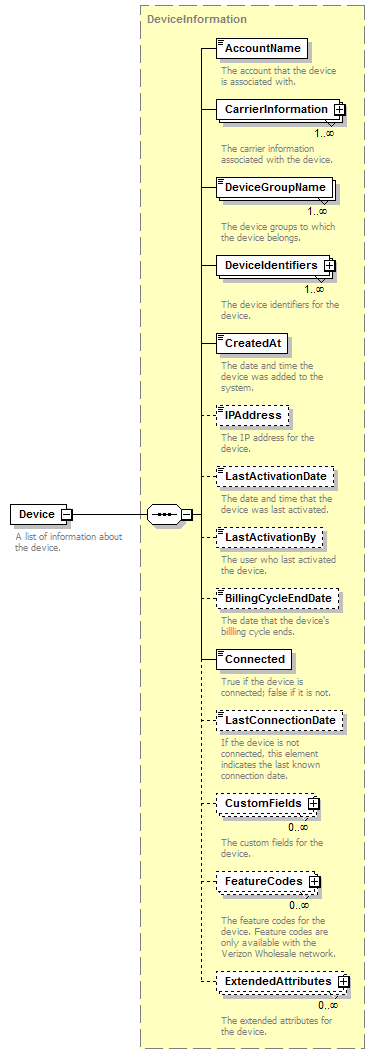 |
||
| namespace | http://nphase.com/unifiedwebservice/v2 | ||
| type | DeviceInformation | ||
| properties |
|
||
| children | AccountName CarrierInformation DeviceGroupName DeviceIdentifiers CreatedAt IPAddress LastActivationDate LastActivationBy BillingCycleEndDate Connected LastConnectionDate CustomFields FeatureCodes ExtendedAttributes | ||
| annotation |
|
||
| source | <xs:element name="Device" type="DeviceInformation"> <xs:annotation> <xs:documentation>A list of information about the device.</xs:documentation> </xs:annotation> </xs:element> |
element GetDeviceListRequest
| diagram | 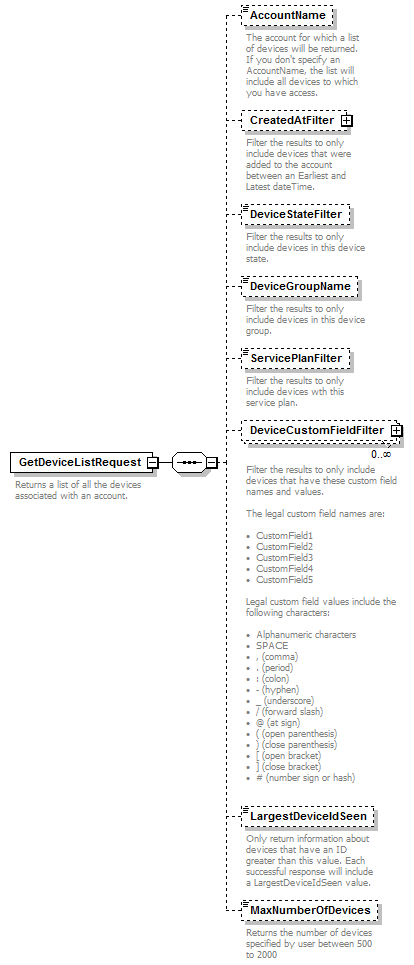 |
||
| namespace | http://nphase.com/unifiedwebservice/v2 | ||
| properties |
|
||
| children | AccountName CreatedAtFilter DeviceStateFilter DeviceGroupName ServicePlanFilter DeviceCustomFieldFilter LargestDeviceIdSeen MaxNumberOfDevices | ||
| annotation |
|
||
| source | <xs:element name="GetDeviceListRequest"> <xs:annotation> <xs:documentation>Returns a list of all the devices associated with an account.</xs:documentation> </xs:annotation> <xs:complexType> <xs:sequence> <xs:element name="AccountName" type="xs:string" nillable="true" minOccurs="0"> <xs:annotation> <xs:documentation>The account for which a list of devices will be returned. If you don't specify an AccountName, the list will include all devices to which you have access.</xs:documentation> </xs:annotation> </xs:element> <xs:element name="CreatedAtFilter" type="InclusiveDateTimeRange" nillable="true" minOccurs="0"> <xs:annotation> <xs:documentation>Filter the results to only include devices that were added to the account between an Earliest and Latest dateTime. </xs:documentation> </xs:annotation> </xs:element> <xs:element name="DeviceStateFilter" type="xs:string" nillable="true" minOccurs="0"> <xs:annotation> <xs:documentation>Filter the results to only include devices in this device state.</xs:documentation> </xs:annotation> </xs:element> <xs:element name="DeviceGroupName" type="xs:string" nillable="true" minOccurs="0"> <xs:annotation> <xs:documentation>Filter the results to only include devices in this device group.</xs:documentation> </xs:annotation> </xs:element> <xs:element name="ServicePlanFilter" type="xs:string" nillable="true" minOccurs="0"> <xs:annotation> <xs:documentation>Filter the results to only include devices wth this service plan.</xs:documentation> </xs:annotation> </xs:element> <xs:element name="DeviceCustomFieldFilter" type="CustomFieldObj" nillable="true" minOccurs="0" maxOccurs="unbounded"> <xs:annotation> <xs:documentation>Filter the results to only include devices that have these custom field names and values. The legal custom field names are: • CustomField1 • CustomField2 • CustomField3 • CustomField4 • CustomField5 Legal custom field values include the following characters: • Alphanumeric characters • SPACE • , (comma) • . (period) • : (colon) • - (hyphen) • _ (underscore) • / (forward slash) • @ (at sign) • ( (open parenthesis) • ) (close parenthesis) • [ (open bracket) • ] (close bracket) • # (number sign or hash) </xs:documentation> </xs:annotation> </xs:element> <xs:element name="LargestDeviceIdSeen" type="xs:long" nillable="true" minOccurs="0"> <xs:annotation> <xs:documentation>Only return information about devices that have an ID greater than this value. Each successful response will include a LargestDeviceIdSeen value.</xs:documentation> </xs:annotation> </xs:element> <xs:element name="MaxNumberOfDevices" type="xs:int" nillable="true" minOccurs="0"> <xs:annotation> <xs:documentation>Returns the number of devices specified by user between 500 to 2000</xs:documentation> </xs:annotation> </xs:element> </xs:sequence> </xs:complexType> </xs:element> |
element GetDeviceListRequest/AccountName
| diagram | 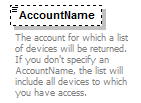 |
||||||||
| namespace | http://nphase.com/unifiedwebservice/v2 | ||||||||
| type | xs:string | ||||||||
| properties |
|
||||||||
| annotation |
|
||||||||
| source | <xs:element name="AccountName" type="xs:string" nillable="true" minOccurs="0"> <xs:annotation> <xs:documentation>The account for which a list of devices will be returned. If you don't specify an AccountName, the list will include all devices to which you have access.</xs:documentation> </xs:annotation> </xs:element> |
element GetDeviceListRequest/CreatedAtFilter
| diagram | 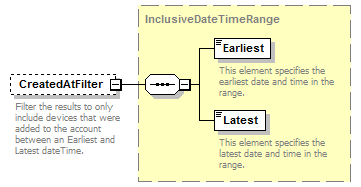 |
||||||||
| namespace | http://nphase.com/unifiedwebservice/v2 | ||||||||
| type | InclusiveDateTimeRange | ||||||||
| properties |
|
||||||||
| children | Earliest Latest | ||||||||
| annotation |
|
||||||||
| source | <xs:element name="CreatedAtFilter" type="InclusiveDateTimeRange" nillable="true" minOccurs="0"> <xs:annotation> <xs:documentation>Filter the results to only include devices that were added to the account between an Earliest and Latest dateTime. </xs:documentation> </xs:annotation> </xs:element> |
element GetDeviceListRequest/DeviceStateFilter
| diagram |  |
||||||||
| namespace | http://nphase.com/unifiedwebservice/v2 | ||||||||
| type | xs:string | ||||||||
| properties |
|
||||||||
| annotation |
|
||||||||
| source | <xs:element name="DeviceStateFilter" type="xs:string" nillable="true" minOccurs="0"> <xs:annotation> <xs:documentation>Filter the results to only include devices in this device state.</xs:documentation> </xs:annotation> </xs:element> |
element GetDeviceListRequest/DeviceGroupName
| diagram |  |
||||||||
| namespace | http://nphase.com/unifiedwebservice/v2 | ||||||||
| type | xs:string | ||||||||
| properties |
|
||||||||
| annotation |
|
||||||||
| source | <xs:element name="DeviceGroupName" type="xs:string" nillable="true" minOccurs="0"> <xs:annotation> <xs:documentation>Filter the results to only include devices in this device group.</xs:documentation> </xs:annotation> </xs:element> |
element GetDeviceListRequest/ServicePlanFilter
| diagram |  |
||||||||
| namespace | http://nphase.com/unifiedwebservice/v2 | ||||||||
| type | xs:string | ||||||||
| properties |
|
||||||||
| annotation |
|
||||||||
| source | <xs:element name="ServicePlanFilter" type="xs:string" nillable="true" minOccurs="0"> <xs:annotation> <xs:documentation>Filter the results to only include devices wth this service plan.</xs:documentation> </xs:annotation> </xs:element> |
element GetDeviceListRequest/DeviceCustomFieldFilter
| diagram |  |
||||||||
| namespace | http://nphase.com/unifiedwebservice/v2 | ||||||||
| type | CustomFieldObj | ||||||||
| properties |
|
||||||||
| children | Name Value | ||||||||
| annotation |
|
||||||||
| source | <xs:element name="DeviceCustomFieldFilter" type="CustomFieldObj" nillable="true" minOccurs="0" maxOccurs="unbounded"> <xs:annotation> <xs:documentation>Filter the results to only include devices that have these custom field names and values. The legal custom field names are: • CustomField1 • CustomField2 • CustomField3 • CustomField4 • CustomField5 Legal custom field values include the following characters: • Alphanumeric characters • SPACE • , (comma) • . (period) • : (colon) • - (hyphen) • _ (underscore) • / (forward slash) • @ (at sign) • ( (open parenthesis) • ) (close parenthesis) • [ (open bracket) • ] (close bracket) • # (number sign or hash) </xs:documentation> </xs:annotation> </xs:element> |
element GetDeviceListRequest/LargestDeviceIdSeen
| diagram |  |
||||||||
| namespace | http://nphase.com/unifiedwebservice/v2 | ||||||||
| type | xs:long | ||||||||
| properties |
|
||||||||
| annotation |
|
||||||||
| source | <xs:element name="LargestDeviceIdSeen" type="xs:long" nillable="true" minOccurs="0"> <xs:annotation> <xs:documentation>Only return information about devices that have an ID greater than this value. Each successful response will include a LargestDeviceIdSeen value.</xs:documentation> </xs:annotation> </xs:element> |
element GetDeviceListRequest/MaxNumberOfDevices
| diagram |  |
||||||||
| namespace | http://nphase.com/unifiedwebservice/v2 | ||||||||
| type | xs:int | ||||||||
| properties |
|
||||||||
| annotation |
|
||||||||
| source | <xs:element name="MaxNumberOfDevices" type="xs:int" nillable="true" minOccurs="0"> <xs:annotation> <xs:documentation>Returns the number of devices specified by user between 500 to 2000</xs:documentation> </xs:annotation> </xs:element> |
element GetDeviceListResponse
| diagram | 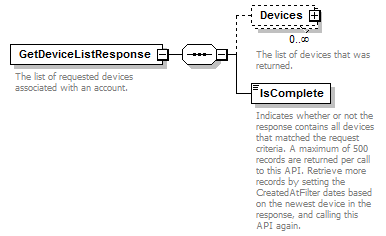 |
||
| namespace | http://nphase.com/unifiedwebservice/v2 | ||
| properties |
|
||
| children | Devices IsComplete | ||
| annotation |
|
||
| source | <xs:element name="GetDeviceListResponse"> <xs:annotation> <xs:documentation>The list of requested devices associated with an account.</xs:documentation> </xs:annotation> <xs:complexType> <xs:sequence> <xs:element name="Devices" type="DeviceInformation" nillable="true" minOccurs="0" maxOccurs="unbounded"> <xs:annotation> <xs:documentation>The list of devices that was returned.</xs:documentation> </xs:annotation> </xs:element> <xs:element name="IsComplete" type="xs:boolean"> <xs:annotation> <xs:documentation>Indicates whether or not the response contains all devices that matched the request criteria. A maximum of 500 records are returned per call to this API. Retrieve more records by setting the CreatedAtFilter dates based on the newest device in the response, and calling this API again.</xs:documentation> </xs:annotation> </xs:element> </xs:sequence> </xs:complexType> </xs:element> |
element GetDeviceListResponse/Devices
| diagram | 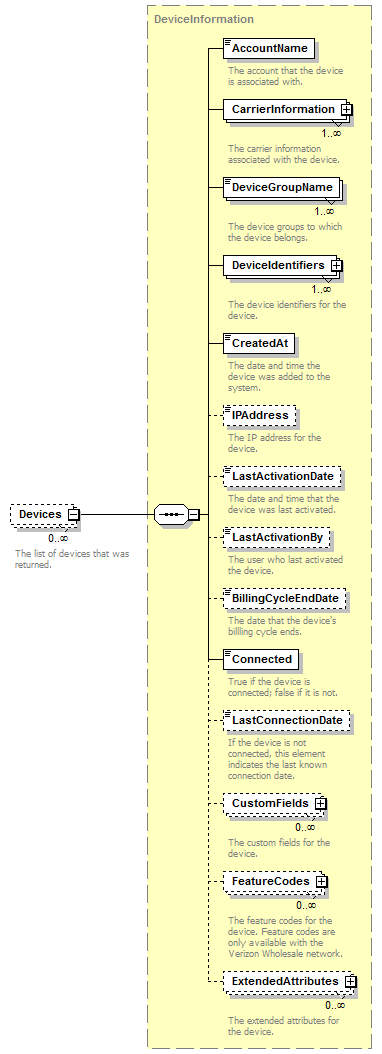 |
||||||||
| namespace | http://nphase.com/unifiedwebservice/v2 | ||||||||
| type | DeviceInformation | ||||||||
| properties |
|
||||||||
| children | AccountName CarrierInformation DeviceGroupName DeviceIdentifiers CreatedAt IPAddress LastActivationDate LastActivationBy BillingCycleEndDate Connected LastConnectionDate CustomFields FeatureCodes ExtendedAttributes | ||||||||
| annotation |
|
||||||||
| source | <xs:element name="Devices" type="DeviceInformation" nillable="true" minOccurs="0" maxOccurs="unbounded"> <xs:annotation> <xs:documentation>The list of devices that was returned.</xs:documentation> </xs:annotation> </xs:element> |
element GetDeviceListResponse/IsComplete
| diagram | 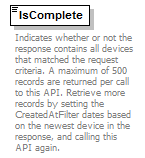 |
||
| namespace | http://nphase.com/unifiedwebservice/v2 | ||
| type | xs:boolean | ||
| properties |
|
||
| annotation |
|
||
| source | <xs:element name="IsComplete" type="xs:boolean"> <xs:annotation> <xs:documentation>Indicates whether or not the response contains all devices that matched the request criteria. A maximum of 500 records are returned per call to this API. Retrieve more records by setting the CreatedAtFilter dates based on the newest device in the response, and calling this API again.</xs:documentation> </xs:annotation> </xs:element> |
element GetDevicePRLInformationRequest
| diagram | 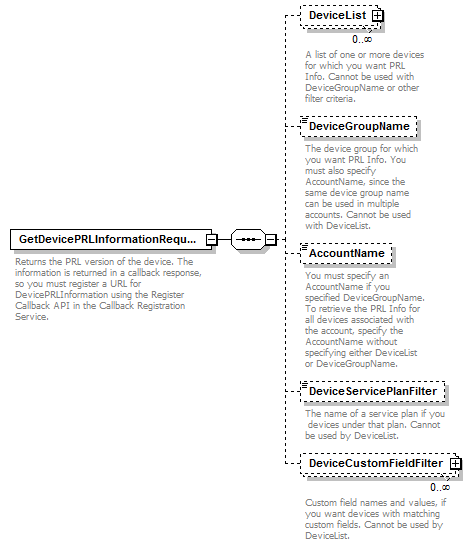 |
||
| namespace | http://nphase.com/unifiedwebservice/v2 | ||
| properties |
|
||
| children | DeviceList DeviceGroupName AccountName DeviceServicePlanFilter DeviceCustomFieldFilter | ||
| annotation |
|
||
| source | <xs:element name="GetDevicePRLInformationRequest"> <xs:annotation> <xs:documentation>Returns the PRL version of the device. The information is returned in a callback response, so you must register a URL for DevicePRLInformation using the Register Callback API in the Callback Registration Service. </xs:documentation> </xs:annotation> <xs:complexType> <xs:sequence> <xs:element name="DeviceList" type="DeviceIdentifier" nillable="true" minOccurs="0" maxOccurs="unbounded"> <xs:annotation> <xs:documentation>A list of one or more devices for which you want PRL Info. Cannot be used with DeviceGroupName or other filter criteria.</xs:documentation> </xs:annotation> </xs:element> <xs:element name="DeviceGroupName" type="xs:string" nillable="true" minOccurs="0"> <xs:annotation> <xs:documentation>The device group for which you want PRL Info. You must also specify AccountName, since the same device group name can be used in multiple accounts. Cannot be used with DeviceList.</xs:documentation> </xs:annotation> </xs:element> <xs:element name="AccountName" type="xs:string" minOccurs="0"> <xs:annotation> <xs:documentation>You must specify an AccountName if you specified DeviceGroupName. To retrieve the PRL Info for all devices associated with the account, specify the AccountName without specifying either DeviceList or DeviceGroupName.</xs:documentation> </xs:annotation> </xs:element> <xs:element name="DeviceServicePlanFilter" type="xs:string" minOccurs="0"> <xs:annotation> <xs:documentation>The name of a service plan if you devices under that plan. Cannot be used by DeviceList.</xs:documentation> </xs:annotation> </xs:element> <xs:element name="DeviceCustomFieldFilter" type="CustomFieldFilterObj" nillable="true" minOccurs="0" maxOccurs="unbounded"> <xs:annotation> <xs:documentation>Custom field names and values, if you want devices with matching custom fields. Cannot be used by DeviceList.</xs:documentation> </xs:annotation> </xs:element> </xs:sequence> </xs:complexType> </xs:element> |
element GetDevicePRLInformationRequest/DeviceList
| diagram | 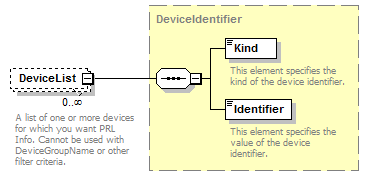 |
||||||||
| namespace | http://nphase.com/unifiedwebservice/v2 | ||||||||
| type | DeviceIdentifier | ||||||||
| properties |
|
||||||||
| children | Kind Identifier | ||||||||
| annotation |
|
||||||||
| source | <xs:element name="DeviceList" type="DeviceIdentifier" nillable="true" minOccurs="0" maxOccurs="unbounded"> <xs:annotation> <xs:documentation>A list of one or more devices for which you want PRL Info. Cannot be used with DeviceGroupName or other filter criteria.</xs:documentation> </xs:annotation> </xs:element> |
element GetDevicePRLInformationRequest/DeviceGroupName
| diagram | 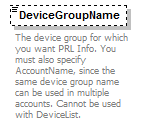 |
||||||||
| namespace | http://nphase.com/unifiedwebservice/v2 | ||||||||
| type | xs:string | ||||||||
| properties |
|
||||||||
| annotation |
|
||||||||
| source | <xs:element name="DeviceGroupName" type="xs:string" nillable="true" minOccurs="0"> <xs:annotation> <xs:documentation>The device group for which you want PRL Info. You must also specify AccountName, since the same device group name can be used in multiple accounts. Cannot be used with DeviceList.</xs:documentation> </xs:annotation> </xs:element> |
element GetDevicePRLInformationRequest/AccountName
| diagram | 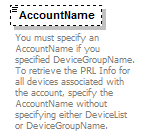 |
||||||
| namespace | http://nphase.com/unifiedwebservice/v2 | ||||||
| type | xs:string | ||||||
| properties |
|
||||||
| annotation |
|
||||||
| source | <xs:element name="AccountName" type="xs:string" minOccurs="0"> <xs:annotation> <xs:documentation>You must specify an AccountName if you specified DeviceGroupName. To retrieve the PRL Info for all devices associated with the account, specify the AccountName without specifying either DeviceList or DeviceGroupName.</xs:documentation> </xs:annotation> </xs:element> |
element GetDevicePRLInformationRequest/DeviceServicePlanFilter
| diagram |  |
||||||
| namespace | http://nphase.com/unifiedwebservice/v2 | ||||||
| type | xs:string | ||||||
| properties |
|
||||||
| annotation |
|
||||||
| source | <xs:element name="DeviceServicePlanFilter" type="xs:string" minOccurs="0"> <xs:annotation> <xs:documentation>The name of a service plan if you devices under that plan. Cannot be used by DeviceList.</xs:documentation> </xs:annotation> </xs:element> |
element GetDevicePRLInformationRequest/DeviceCustomFieldFilter
| diagram | 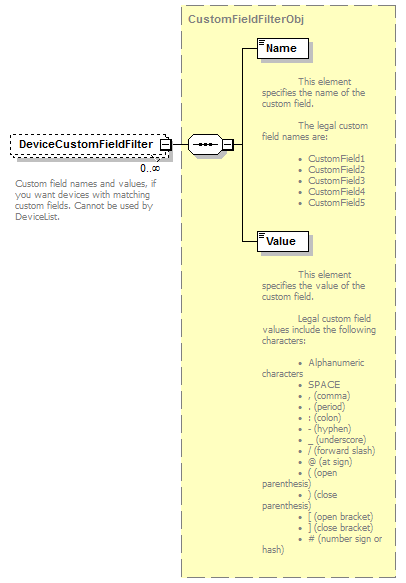 |
||||||||
| namespace | http://nphase.com/unifiedwebservice/v2 | ||||||||
| type | CustomFieldFilterObj | ||||||||
| properties |
|
||||||||
| children | Name Value | ||||||||
| annotation |
|
||||||||
| source | <xs:element name="DeviceCustomFieldFilter" type="CustomFieldFilterObj" nillable="true" minOccurs="0" maxOccurs="unbounded"> <xs:annotation> <xs:documentation>Custom field names and values, if you want devices with matching custom fields. Cannot be used by DeviceList.</xs:documentation> </xs:annotation> </xs:element> |
element GetDevicePRLInformationResponse
| diagram |  |
||
| namespace | http://nphase.com/unifiedwebservice/v2 | ||
| properties |
|
||
| children | RequestId | ||
| annotation |
|
||
| source | <xs:element name="GetDevicePRLInformationResponse"> <xs:annotation> <xs:documentation>Returns a unique request ID if the request was successfully sent.</xs:documentation> </xs:annotation> <xs:complexType> <xs:sequence> <xs:element name="RequestId" type="xs:string"> <xs:annotation> <xs:documentation>A unique ID that associates the request with the results that are sent via a callback service.</xs:documentation> </xs:annotation> </xs:element> </xs:sequence> </xs:complexType> </xs:element> |
element GetDevicePRLInformationResponse/RequestId
| diagram |  |
||
| namespace | http://nphase.com/unifiedwebservice/v2 | ||
| type | xs:string | ||
| properties |
|
||
| annotation |
|
||
| source | <xs:element name="RequestId" type="xs:string"> <xs:annotation> <xs:documentation>A unique ID that associates the request with the results that are sent via a callback service.</xs:documentation> </xs:annotation> </xs:element> |
element GetDeviceProvisioningHistoryRequest
| diagram |  |
||
| namespace | http://nphase.com/unifiedwebservice/v2 | ||
| properties |
|
||
| children | Device OccurredAtFilter | ||
| annotation |
|
||
| source | <xs:element name="GetDeviceProvisioningHistoryRequest"> <xs:annotation> <xs:documentation>Returns the provisioning history of a specified device. You can specify a time period to see only events during that period.</xs:documentation> </xs:annotation> <xs:complexType> <xs:sequence> <xs:element name="Device" type="DeviceIdentifier"> <xs:annotation> <xs:documentation>The device for which the provisioning history will be returned.</xs:documentation> </xs:annotation> </xs:element> <xs:element name="OccurredAtFilter" type="InclusiveDateTimeRange"> <xs:annotation> <xs:documentation>Restrict the results to only include provisioning events that occurred between an Earliest and Latest dateTime. </xs:documentation> </xs:annotation> </xs:element> </xs:sequence> </xs:complexType> </xs:element> |
element GetDeviceProvisioningHistoryRequest/Device
| diagram | 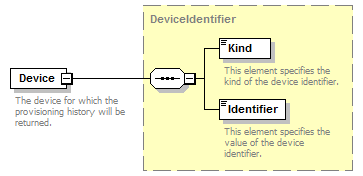 |
||
| namespace | http://nphase.com/unifiedwebservice/v2 | ||
| type | DeviceIdentifier | ||
| properties |
|
||
| children | Kind Identifier | ||
| annotation |
|
||
| source | <xs:element name="Device" type="DeviceIdentifier"> <xs:annotation> <xs:documentation>The device for which the provisioning history will be returned.</xs:documentation> </xs:annotation> </xs:element> |
element GetDeviceProvisioningHistoryRequest/OccurredAtFilter
| diagram | 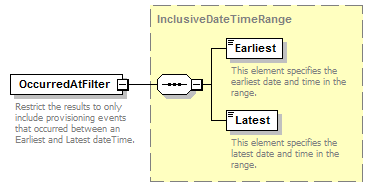 |
||
| namespace | http://nphase.com/unifiedwebservice/v2 | ||
| type | InclusiveDateTimeRange | ||
| properties |
|
||
| children | Earliest Latest | ||
| annotation |
|
||
| source | <xs:element name="OccurredAtFilter" type="InclusiveDateTimeRange"> <xs:annotation> <xs:documentation>Restrict the results to only include provisioning events that occurred between an Earliest and Latest dateTime. </xs:documentation> </xs:annotation> </xs:element> |
element GetDeviceProvisioningHistoryResponse
| diagram | 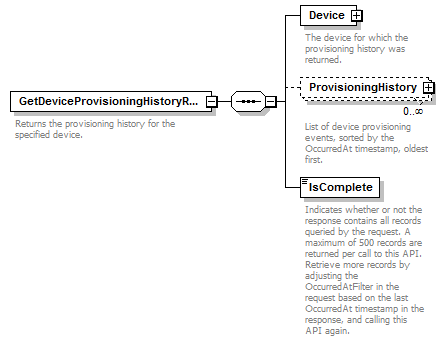 |
||
| namespace | http://nphase.com/unifiedwebservice/v2 | ||
| properties |
|
||
| children | Device ProvisioningHistory IsComplete | ||
| annotation |
|
||
| source | <xs:element name="GetDeviceProvisioningHistoryResponse"> <xs:annotation> <xs:documentation>Returns the provisioning history for the specified device.</xs:documentation> </xs:annotation> <xs:complexType> <xs:sequence> <xs:element name="Device" type="DeviceIdentifier"> <xs:annotation> <xs:documentation>The device for which the provisioning history was returned.</xs:documentation> </xs:annotation> </xs:element> <xs:element name="ProvisioningHistory" type="ProvisioningEvent" nillable="true" minOccurs="0" maxOccurs="unbounded"> <xs:annotation> <xs:documentation>List of device provisioning events, sorted by the OccurredAt timestamp, oldest first.</xs:documentation> </xs:annotation> </xs:element> <xs:element name="IsComplete" type="xs:boolean"> <xs:annotation> <xs:documentation>Indicates whether or not the response contains all records queried by the request. A maximum of 500 records are returned per call to this API. Retrieve more records by adjusting the OccurredAtFilter in the request based on the last OccurredAt timestamp in the response, and calling this API again.</xs:documentation> </xs:annotation> </xs:element> </xs:sequence> </xs:complexType> </xs:element> |
element GetDeviceProvisioningHistoryResponse/Device
| diagram | 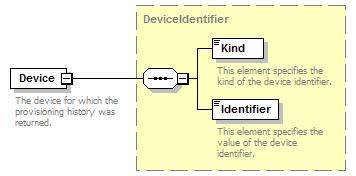 |
||
| namespace | http://nphase.com/unifiedwebservice/v2 | ||
| type | DeviceIdentifier | ||
| properties |
|
||
| children | Kind Identifier | ||
| annotation |
|
||
| source | <xs:element name="Device" type="DeviceIdentifier"> <xs:annotation> <xs:documentation>The device for which the provisioning history was returned.</xs:documentation> </xs:annotation> </xs:element> |
element GetDeviceProvisioningHistoryResponse/ProvisioningHistory
| diagram | 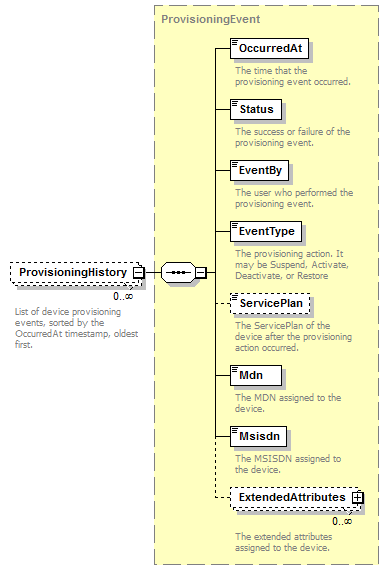 |
||||||||
| namespace | http://nphase.com/unifiedwebservice/v2 | ||||||||
| type | ProvisioningEvent | ||||||||
| properties |
|
||||||||
| children | OccurredAt Status EventBy EventType ServicePlan Mdn Msisdn ExtendedAttributes | ||||||||
| annotation |
|
||||||||
| source | <xs:element name="ProvisioningHistory" type="ProvisioningEvent" nillable="true" minOccurs="0" maxOccurs="unbounded"> <xs:annotation> <xs:documentation>List of device provisioning events, sorted by the OccurredAt timestamp, oldest first.</xs:documentation> </xs:annotation> </xs:element> |
element GetDeviceProvisioningHistoryResponse/IsComplete
| diagram | 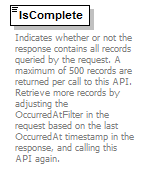 |
||
| namespace | http://nphase.com/unifiedwebservice/v2 | ||
| type | xs:boolean | ||
| properties |
|
||
| annotation |
|
||
| source | <xs:element name="IsComplete" type="xs:boolean"> <xs:annotation> <xs:documentation>Indicates whether or not the response contains all records queried by the request. A maximum of 500 records are returned per call to this API. Retrieve more records by adjusting the OccurredAtFilter in the request based on the last OccurredAt timestamp in the response, and calling this API again.</xs:documentation> </xs:annotation> </xs:element> |
element GetDeviceSuspensionStatusRequest
| diagram |  |
||
| namespace | http://nphase.com/unifiedwebservice/v2 | ||
| properties |
|
||
| children | DeviceList DeviceGroupName AccountName DeviceServicePlanFilter DeviceCustomFieldFilter | ||
| annotation |
|
||
| source | <xs:element name="GetDeviceSuspensionStatusRequest"> <xs:annotation> <xs:documentation>Returns the Suspension Status of the device. The information is returned in a callback response, so you must register a URL for DeviceSuspendStatus using the Register Callback API in the Callback Registration Service. </xs:documentation> </xs:annotation> <xs:complexType> <xs:sequence> <xs:element name="DeviceList" type="DeviceIdentifier" nillable="true" minOccurs="0" maxOccurs="unbounded"> <xs:annotation> <xs:documentation>A list of one or more devices for which you want suspension status. Cannot be used with DeviceGroupName.</xs:documentation> </xs:annotation> </xs:element> <xs:element name="DeviceGroupName" type="xs:string" nillable="true" minOccurs="0"> <xs:annotation> <xs:documentation>The device group for which you want suspension status. You must also specify AccountName, since the same device group name can be used in multiple accounts. Cannot be used with DeviceList.</xs:documentation> </xs:annotation> </xs:element> <xs:element name="AccountName" type="xs:string" minOccurs="0"> <xs:annotation> <xs:documentation>You must specify an AccountName if you specified DeviceGroupName. To retrieve the suspension status for all devices associated with the account, specify the AccountName without specifying either DeviceList or DeviceGroupName.</xs:documentation> </xs:annotation> </xs:element> <xs:element name="DeviceServicePlanFilter" type="xs:string" minOccurs="0"> <xs:annotation> <xs:documentation>The name of a service plan if you devices under that plan. Cannot be used by DeviceList.</xs:documentation> </xs:annotation> </xs:element> <xs:element name="DeviceCustomFieldFilter" type="CustomFieldFilterObj" nillable="true" minOccurs="0" maxOccurs="unbounded"> <xs:annotation> <xs:documentation>Custom field names and values, if you want devices with matching custom fields. Cannot be used by DeviceList.</xs:documentation> </xs:annotation> </xs:element> </xs:sequence> </xs:complexType> </xs:element> |
element GetDeviceSuspensionStatusRequest/DeviceList
| diagram | 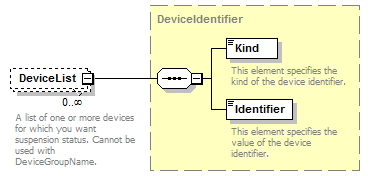 |
||||||||
| namespace | http://nphase.com/unifiedwebservice/v2 | ||||||||
| type | DeviceIdentifier | ||||||||
| properties |
|
||||||||
| children | Kind Identifier | ||||||||
| annotation |
|
||||||||
| source | <xs:element name="DeviceList" type="DeviceIdentifier" nillable="true" minOccurs="0" maxOccurs="unbounded"> <xs:annotation> <xs:documentation>A list of one or more devices for which you want suspension status. Cannot be used with DeviceGroupName.</xs:documentation> </xs:annotation> </xs:element> |
element GetDeviceSuspensionStatusRequest/DeviceGroupName
| diagram |  |
||||||||
| namespace | http://nphase.com/unifiedwebservice/v2 | ||||||||
| type | xs:string | ||||||||
| properties |
|
||||||||
| annotation |
|
||||||||
| source | <xs:element name="DeviceGroupName" type="xs:string" nillable="true" minOccurs="0"> <xs:annotation> <xs:documentation>The device group for which you want suspension status. You must also specify AccountName, since the same device group name can be used in multiple accounts. Cannot be used with DeviceList.</xs:documentation> </xs:annotation> </xs:element> |
element GetDeviceSuspensionStatusRequest/AccountName
| diagram | 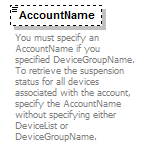 |
||||||
| namespace | http://nphase.com/unifiedwebservice/v2 | ||||||
| type | xs:string | ||||||
| properties |
|
||||||
| annotation |
|
||||||
| source | <xs:element name="AccountName" type="xs:string" minOccurs="0"> <xs:annotation> <xs:documentation>You must specify an AccountName if you specified DeviceGroupName. To retrieve the suspension status for all devices associated with the account, specify the AccountName without specifying either DeviceList or DeviceGroupName.</xs:documentation> </xs:annotation> </xs:element> |
element GetDeviceSuspensionStatusRequest/DeviceServicePlanFilter
| diagram |  |
||||||
| namespace | http://nphase.com/unifiedwebservice/v2 | ||||||
| type | xs:string | ||||||
| properties |
|
||||||
| annotation |
|
||||||
| source | <xs:element name="DeviceServicePlanFilter" type="xs:string" minOccurs="0"> <xs:annotation> <xs:documentation>The name of a service plan if you devices under that plan. Cannot be used by DeviceList.</xs:documentation> </xs:annotation> </xs:element> |
element GetDeviceSuspensionStatusRequest/DeviceCustomFieldFilter
| diagram | 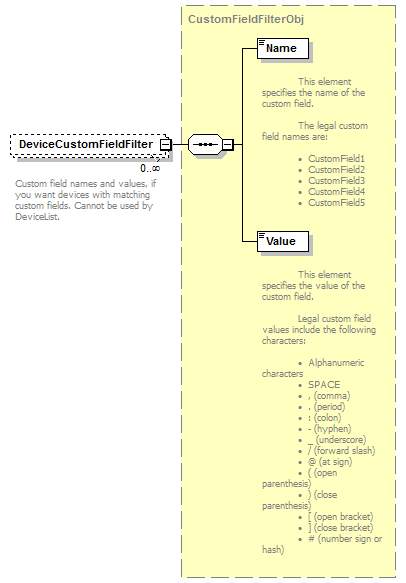 |
||||||||
| namespace | http://nphase.com/unifiedwebservice/v2 | ||||||||
| type | CustomFieldFilterObj | ||||||||
| properties |
|
||||||||
| children | Name Value | ||||||||
| annotation |
|
||||||||
| source | <xs:element name="DeviceCustomFieldFilter" type="CustomFieldFilterObj" nillable="true" minOccurs="0" maxOccurs="unbounded"> <xs:annotation> <xs:documentation>Custom field names and values, if you want devices with matching custom fields. Cannot be used by DeviceList.</xs:documentation> </xs:annotation> </xs:element> |
element GetDeviceSuspensionStatusResponse
| diagram |  |
||
| namespace | http://nphase.com/unifiedwebservice/v2 | ||
| properties |
|
||
| children | RequestId | ||
| annotation |
|
||
| source | <xs:element name="GetDeviceSuspensionStatusResponse"> <xs:annotation> <xs:documentation>Returns a unique request ID if the request was successfully sent.</xs:documentation> </xs:annotation> <xs:complexType> <xs:sequence> <xs:element name="RequestId" type="xs:string"> <xs:annotation> <xs:documentation>A unique ID that associates the request with the results that are sent via a callback service.</xs:documentation> </xs:annotation> </xs:element> </xs:sequence> </xs:complexType> </xs:element> |
element GetDeviceSuspensionStatusResponse/RequestId
| diagram |  |
||
| namespace | http://nphase.com/unifiedwebservice/v2 | ||
| type | xs:string | ||
| properties |
|
||
| annotation |
|
||
| source | <xs:element name="RequestId" type="xs:string"> <xs:annotation> <xs:documentation>A unique ID that associates the request with the results that are sent via a callback service.</xs:documentation> </xs:annotation> </xs:element> |
element GetDeviceUsageHistoryRequest
| diagram | 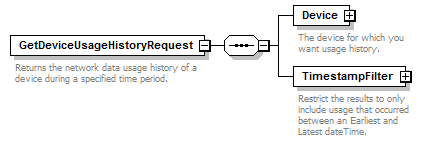 |
||
| namespace | http://nphase.com/unifiedwebservice/v2 | ||
| properties |
|
||
| children | Device TimestampFilter | ||
| annotation |
|
||
| source | <xs:element name="GetDeviceUsageHistoryRequest"> <xs:annotation> <xs:documentation>Returns the network data usage history of a device during a specified time period.</xs:documentation> </xs:annotation> <xs:complexType> <xs:sequence> <xs:element name="Device" type="DeviceIdentifier"> <xs:annotation> <xs:documentation>The device for which you want usage history.</xs:documentation> </xs:annotation> </xs:element> <xs:element name="TimestampFilter" type="InclusiveDateTimeRange"> <xs:annotation> <xs:documentation>Restrict the results to only include usage that occurred between an Earliest and Latest dateTime.</xs:documentation> </xs:annotation> </xs:element> </xs:sequence> </xs:complexType> </xs:element> |
element GetDeviceUsageHistoryRequest/Device
| diagram |  |
||
| namespace | http://nphase.com/unifiedwebservice/v2 | ||
| type | DeviceIdentifier | ||
| properties |
|
||
| children | Kind Identifier | ||
| annotation |
|
||
| source | <xs:element name="Device" type="DeviceIdentifier"> <xs:annotation> <xs:documentation>The device for which you want usage history.</xs:documentation> </xs:annotation> </xs:element> |
element GetDeviceUsageHistoryRequest/TimestampFilter
| diagram |  |
||
| namespace | http://nphase.com/unifiedwebservice/v2 | ||
| type | InclusiveDateTimeRange | ||
| properties |
|
||
| children | Earliest Latest | ||
| annotation |
|
||
| source | <xs:element name="TimestampFilter" type="InclusiveDateTimeRange"> <xs:annotation> <xs:documentation>Restrict the results to only include usage that occurred between an Earliest and Latest dateTime.</xs:documentation> </xs:annotation> </xs:element> |
element GetDeviceUsageHistoryResponse
| diagram | 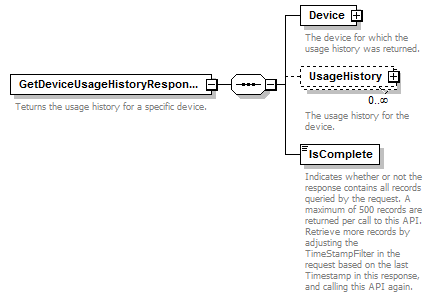 |
||
| namespace | http://nphase.com/unifiedwebservice/v2 | ||
| properties |
|
||
| children | Device UsageHistory IsComplete | ||
| annotation |
|
||
| source | <xs:element name="GetDeviceUsageHistoryResponse"> <xs:annotation> <xs:documentation>Teturns the usage history for a specific device.</xs:documentation> </xs:annotation> <xs:complexType> <xs:sequence> <xs:element name="Device" type="DeviceIdentifier"> <xs:annotation> <xs:documentation>The device for which the usage history was returned.</xs:documentation> </xs:annotation> </xs:element> <xs:element name="UsageHistory" type="DeviceUsage" nillable="true" minOccurs="0" maxOccurs="unbounded"> <xs:annotation> <xs:documentation>The usage history for the device.</xs:documentation> </xs:annotation> </xs:element> <xs:element name="IsComplete" type="xs:boolean"> <xs:annotation> <xs:documentation>Indicates whether or not the response contains all records queried by the request. A maximum of 500 records are returned per call to this API. Retrieve more records by adjusting the TimeStampFilter in the request based on the last Timestamp in this response, and calling this API again.</xs:documentation> </xs:annotation> </xs:element> </xs:sequence> </xs:complexType> </xs:element> |
element GetDeviceUsageHistoryResponse/Device
| diagram | 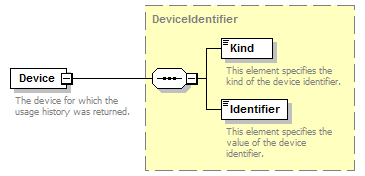 |
||
| namespace | http://nphase.com/unifiedwebservice/v2 | ||
| type | DeviceIdentifier | ||
| properties |
|
||
| children | Kind Identifier | ||
| annotation |
|
||
| source | <xs:element name="Device" type="DeviceIdentifier"> <xs:annotation> <xs:documentation>The device for which the usage history was returned.</xs:documentation> </xs:annotation> </xs:element> |
element GetDeviceUsageHistoryResponse/UsageHistory
| diagram | 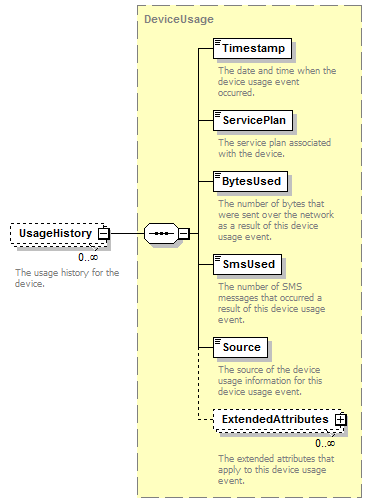 |
||||||||
| namespace | http://nphase.com/unifiedwebservice/v2 | ||||||||
| type | DeviceUsage | ||||||||
| properties |
|
||||||||
| children | Timestamp ServicePlan BytesUsed SmsUsed Source ExtendedAttributes | ||||||||
| annotation |
|
||||||||
| source | <xs:element name="UsageHistory" type="DeviceUsage" nillable="true" minOccurs="0" maxOccurs="unbounded"> <xs:annotation> <xs:documentation>The usage history for the device.</xs:documentation> </xs:annotation> </xs:element> |
element GetDeviceUsageHistoryResponse/IsComplete
| diagram | 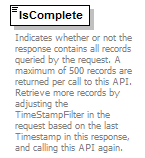 |
||
| namespace | http://nphase.com/unifiedwebservice/v2 | ||
| type | xs:boolean | ||
| properties |
|
||
| annotation |
|
||
| source | <xs:element name="IsComplete" type="xs:boolean"> <xs:annotation> <xs:documentation>Indicates whether or not the response contains all records queried by the request. A maximum of 500 records are returned per call to this API. Retrieve more records by adjusting the TimeStampFilter in the request based on the last Timestamp in this response, and calling this API again.</xs:documentation> </xs:annotation> </xs:element> |
element GetRatedDeviceUsageRequest
| diagram | 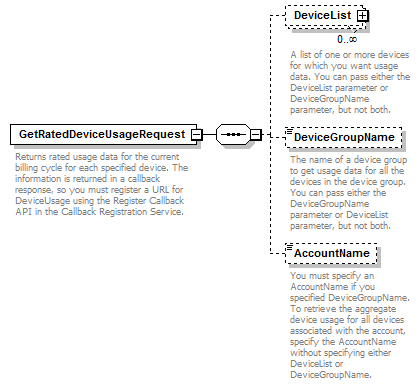 |
||
| namespace | http://nphase.com/unifiedwebservice/v2 | ||
| properties |
|
||
| children | DeviceList DeviceGroupName AccountName | ||
| annotation |
|
||
| source | <xs:element name="GetRatedDeviceUsageRequest"> <xs:annotation> <xs:documentation>Returns rated usage data for the current billing cycle for each specified device. The information is returned in a callback response, so you must register a URL for DeviceUsage using the Register Callback API in the Callback Registration Service.</xs:documentation> </xs:annotation> <xs:complexType> <xs:sequence> <xs:element name="DeviceList" type="DeviceIdentifier" nillable="true" minOccurs="0" maxOccurs="unbounded"> <xs:annotation> <xs:documentation>A list of one or more devices for which you want usage data. You can pass either the DeviceList parameter or DeviceGroupName parameter, but not both.</xs:documentation> </xs:annotation> </xs:element> <xs:element name="DeviceGroupName" type="xs:string" nillable="true" minOccurs="0"> <xs:annotation> <xs:documentation>The name of a device group to get usage data for all the devices in the device group. You can pass either the DeviceGroupName parameter or DeviceList parameter, but not both.</xs:documentation> </xs:annotation> </xs:element> <xs:element name="AccountName" type="xs:string" minOccurs="0"> <xs:annotation> <xs:documentation>You must specify an AccountName if you specified DeviceGroupName. To retrieve the aggregate device usage for all devices associated with the account, specify the AccountName without specifying either DeviceList or DeviceGroupName.</xs:documentation> </xs:annotation> </xs:element> </xs:sequence> </xs:complexType> </xs:element> |
element GetRatedDeviceUsageRequest/DeviceList
| diagram | 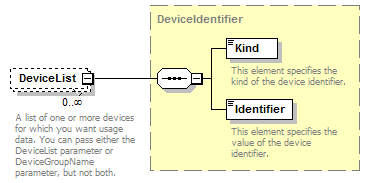 |
||||||||
| namespace | http://nphase.com/unifiedwebservice/v2 | ||||||||
| type | DeviceIdentifier | ||||||||
| properties |
|
||||||||
| children | Kind Identifier | ||||||||
| annotation |
|
||||||||
| source | <xs:element name="DeviceList" type="DeviceIdentifier" nillable="true" minOccurs="0" maxOccurs="unbounded"> <xs:annotation> <xs:documentation>A list of one or more devices for which you want usage data. You can pass either the DeviceList parameter or DeviceGroupName parameter, but not both.</xs:documentation> </xs:annotation> </xs:element> |
element GetRatedDeviceUsageRequest/DeviceGroupName
| diagram | 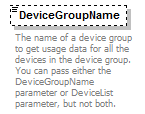 |
||||||||
| namespace | http://nphase.com/unifiedwebservice/v2 | ||||||||
| type | xs:string | ||||||||
| properties |
|
||||||||
| annotation |
|
||||||||
| source | <xs:element name="DeviceGroupName" type="xs:string" nillable="true" minOccurs="0"> <xs:annotation> <xs:documentation>The name of a device group to get usage data for all the devices in the device group. You can pass either the DeviceGroupName parameter or DeviceList parameter, but not both.</xs:documentation> </xs:annotation> </xs:element> |
element GetRatedDeviceUsageRequest/AccountName
| diagram | 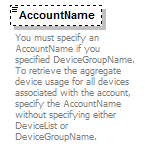 |
||||||
| namespace | http://nphase.com/unifiedwebservice/v2 | ||||||
| type | xs:string | ||||||
| properties |
|
||||||
| annotation |
|
||||||
| source | <xs:element name="AccountName" type="xs:string" minOccurs="0"> <xs:annotation> <xs:documentation>You must specify an AccountName if you specified DeviceGroupName. To retrieve the aggregate device usage for all devices associated with the account, specify the AccountName without specifying either DeviceList or DeviceGroupName.</xs:documentation> </xs:annotation> </xs:element> |
element GetRatedDeviceUsageResponse
| diagram |  |
||
| namespace | http://nphase.com/unifiedwebservice/v2 | ||
| properties |
|
||
| children | RequestId | ||
| annotation |
|
||
| source | <xs:element name="GetRatedDeviceUsageResponse"> <xs:annotation> <xs:documentation>Returns a GUID for the request ID if the request was successfully sent.</xs:documentation> </xs:annotation> <xs:complexType> <xs:sequence> <xs:element name="RequestId" type="xs:string"> <xs:annotation> <xs:documentation>A unique ID that associates the request with the result sent via the callback service.</xs:documentation> </xs:annotation> </xs:element> </xs:sequence> </xs:complexType> </xs:element> |
element GetRatedDeviceUsageResponse/RequestId
| diagram |  |
||
| namespace | http://nphase.com/unifiedwebservice/v2 | ||
| type | xs:string | ||
| properties |
|
||
| annotation |
|
||
| source | <xs:element name="RequestId" type="xs:string"> <xs:annotation> <xs:documentation>A unique ID that associates the request with the result sent via the callback service.</xs:documentation> </xs:annotation> </xs:element> |
complexType CarrierInformation
| diagram | 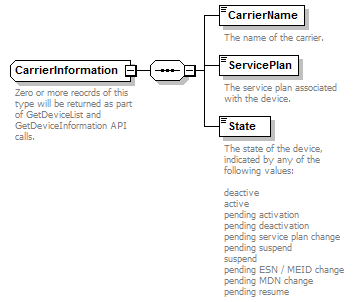 |
||
| namespace | http://nphase.com/unifiedwebservice/v2 | ||
| children | CarrierName ServicePlan State | ||
| used by |
|
||
| annotation |
|
||
| source | <xs:complexType name="CarrierInformation"> <xs:annotation> <xs:documentation>Zero or more reocrds of this type will be returned as part of GetDeviceList and GetDeviceInformation API calls.</xs:documentation> </xs:annotation> <xs:sequence> <xs:element name="CarrierName" type="xs:string" nillable="true"> <xs:annotation> <xs:documentation>The name of the carrier.</xs:documentation> </xs:annotation> </xs:element> <xs:element name="ServicePlan" type="xs:string" nillable="true"> <xs:annotation> <xs:documentation>The service plan associated with the device.</xs:documentation> </xs:annotation> </xs:element> <xs:element name="State" type="xs:string"> <xs:annotation> <xs:documentation>The state of the device, indicated by any of the following values: deactive active pending activation pending deactivation pending service plan change pending suspend suspend pending ESN / MEID change pending MDN change pending resume</xs:documentation> </xs:annotation> </xs:element> </xs:sequence> </xs:complexType> |
element CarrierInformation/CarrierName
| diagram |  |
||||
| namespace | http://nphase.com/unifiedwebservice/v2 | ||||
| type | xs:string | ||||
| properties |
|
||||
| annotation |
|
||||
| source | <xs:element name="CarrierName" type="xs:string" nillable="true"> <xs:annotation> <xs:documentation>The name of the carrier.</xs:documentation> </xs:annotation> </xs:element> |
element CarrierInformation/ServicePlan
| diagram |  |
||||
| namespace | http://nphase.com/unifiedwebservice/v2 | ||||
| type | xs:string | ||||
| properties |
|
||||
| annotation |
|
||||
| source | <xs:element name="ServicePlan" type="xs:string" nillable="true"> <xs:annotation> <xs:documentation>The service plan associated with the device.</xs:documentation> </xs:annotation> </xs:element> |
element CarrierInformation/State
| diagram | 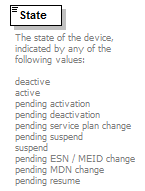 |
||
| namespace | http://nphase.com/unifiedwebservice/v2 | ||
| type | xs:string | ||
| properties |
|
||
| annotation |
|
||
| source | <xs:element name="State" type="xs:string"> <xs:annotation> <xs:documentation>The state of the device, indicated by any of the following values: deactive active pending activation pending deactivation pending service plan change pending suspend suspend pending ESN / MEID change pending MDN change pending resume</xs:documentation> </xs:annotation> </xs:element> |
complexType ConnectionEventAttribute
| diagram |  |
||
| namespace | http://nphase.com/unifiedwebservice/v2 | ||
| children | Key Value | ||
| used by |
|
||
| source | <xs:complexType name="ConnectionEventAttribute"> <xs:sequence> <xs:element name="Key" type="xs:string"> <xs:annotation> <xs:documentation>The key for an attribute.</xs:documentation> </xs:annotation> </xs:element> <xs:element name="Value" type="xs:string"> <xs:annotation> <xs:documentation>The value for an attribute.</xs:documentation> </xs:annotation> </xs:element> </xs:sequence> </xs:complexType> |
element ConnectionEventAttribute/Key
| diagram |  |
||
| namespace | http://nphase.com/unifiedwebservice/v2 | ||
| type | xs:string | ||
| properties |
|
||
| annotation |
|
||
| source | <xs:element name="Key" type="xs:string"> <xs:annotation> <xs:documentation>The key for an attribute.</xs:documentation> </xs:annotation> </xs:element> |
element ConnectionEventAttribute/Value
| diagram |  |
||
| namespace | http://nphase.com/unifiedwebservice/v2 | ||
| type | xs:string | ||
| properties |
|
||
| annotation |
|
||
| source | <xs:element name="Value" type="xs:string"> <xs:annotation> <xs:documentation>The value for an attribute.</xs:documentation> </xs:annotation> </xs:element> |
complexType CustomFieldObj
| diagram | 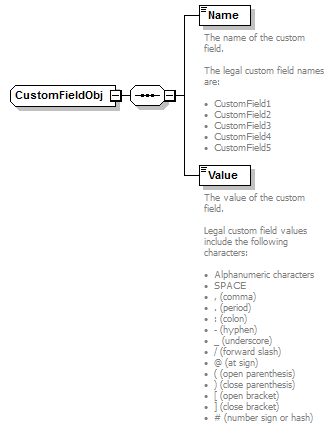 |
||
| namespace | http://nphase.com/unifiedwebservice/v2 | ||
| children | Name Value | ||
| used by |
|
||
| source | <xs:complexType name="CustomFieldObj"> <xs:sequence> <xs:element name="Name" type="xs:string"> <xs:annotation> <xs:documentation>The name of the custom field. The legal custom field names are: • CustomField1 • CustomField2 • CustomField3 • CustomField4 • CustomField5</xs:documentation> </xs:annotation> </xs:element> <xs:element name="Value" type="xs:string"> <xs:annotation> <xs:documentation>The value of the custom field. Legal custom field values include the following characters: • Alphanumeric characters • SPACE • , (comma) • . (period) • : (colon) • - (hyphen) • _ (underscore) • / (forward slash) • @ (at sign) • ( (open parenthesis) • ) (close parenthesis) • [ (open bracket) • ] (close bracket) • # (number sign or hash) </xs:documentation> </xs:annotation> </xs:element> </xs:sequence> </xs:complexType> |
element CustomFieldObj/Name
| diagram | 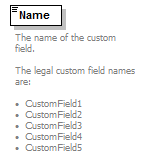 |
||
| namespace | http://nphase.com/unifiedwebservice/v2 | ||
| type | xs:string | ||
| properties |
|
||
| annotation |
|
||
| source | <xs:element name="Name" type="xs:string"> <xs:annotation> <xs:documentation>The name of the custom field. The legal custom field names are: • CustomField1 • CustomField2 • CustomField3 • CustomField4 • CustomField5</xs:documentation> </xs:annotation> </xs:element> |
element CustomFieldObj/Value
| diagram | 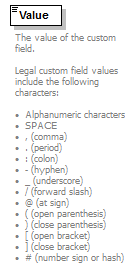 |
||
| namespace | http://nphase.com/unifiedwebservice/v2 | ||
| type | xs:string | ||
| properties |
|
||
| annotation |
|
||
| source | <xs:element name="Value" type="xs:string"> <xs:annotation> <xs:documentation>The value of the custom field. Legal custom field values include the following characters: • Alphanumeric characters • SPACE • , (comma) • . (period) • : (colon) • - (hyphen) • _ (underscore) • / (forward slash) • @ (at sign) • ( (open parenthesis) • ) (close parenthesis) • [ (open bracket) • ] (close bracket) • # (number sign or hash) </xs:documentation> </xs:annotation> </xs:element> |
complexType DeviceCapability
| diagram | 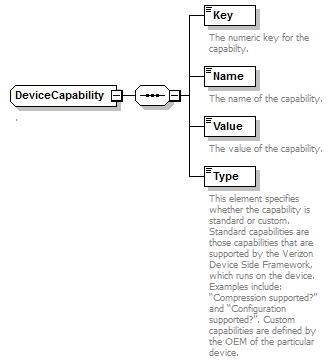 |
||
| namespace | http://nphase.com/unifiedwebservice/v2 | ||
| children | Key Name Value Type | ||
| used by |
|
||
| annotation |
|
||
| source | <xs:complexType name="DeviceCapability"> <xs:annotation> <xs:documentation>.</xs:documentation> </xs:annotation> <xs:sequence> <xs:element name="Key" type="xs:int"> <xs:annotation> <xs:documentation>The numeric key for the capabilty.</xs:documentation> </xs:annotation> </xs:element> <xs:element name="Name" type="xs:string"> <xs:annotation> <xs:documentation>The name of the capability.</xs:documentation> </xs:annotation> </xs:element> <xs:element name="Value" type="xs:string"> <xs:annotation> <xs:documentation>The value of the capability.</xs:documentation> </xs:annotation> </xs:element> <xs:element name="Type" type="xs:string"> <xs:annotation> <xs:documentation>This element specifies whether the capability is standard or custom. Standard capabilities are those capabilities that are supported by the Verizon Device Side Framework, which runs on the device. Examples include: “Compression supported?” and “Configuration supported?”. Custom capabilities are defined by the OEM of the particular device.</xs:documentation> </xs:annotation> </xs:element> </xs:sequence> </xs:complexType> |
element DeviceCapability/Key
| diagram |  |
||
| namespace | http://nphase.com/unifiedwebservice/v2 | ||
| type | xs:int | ||
| properties |
|
||
| annotation |
|
||
| source | <xs:element name="Key" type="xs:int"> <xs:annotation> <xs:documentation>The numeric key for the capabilty.</xs:documentation> </xs:annotation> </xs:element> |
element DeviceCapability/Name
| diagram |  |
||
| namespace | http://nphase.com/unifiedwebservice/v2 | ||
| type | xs:string | ||
| properties |
|
||
| annotation |
|
||
| source | <xs:element name="Name" type="xs:string"> <xs:annotation> <xs:documentation>The name of the capability.</xs:documentation> </xs:annotation> </xs:element> |
element DeviceCapability/Value
| diagram |  |
||
| namespace | http://nphase.com/unifiedwebservice/v2 | ||
| type | xs:string | ||
| properties |
|
||
| annotation |
|
||
| source | <xs:element name="Value" type="xs:string"> <xs:annotation> <xs:documentation>The value of the capability.</xs:documentation> </xs:annotation> </xs:element> |
element DeviceCapability/Type
| diagram | 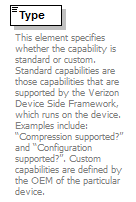 |
||
| namespace | http://nphase.com/unifiedwebservice/v2 | ||
| type | xs:string | ||
| properties |
|
||
| annotation |
|
||
| source | <xs:element name="Type" type="xs:string"> <xs:annotation> <xs:documentation>This element specifies whether the capability is standard or custom. Standard capabilities are those capabilities that are supported by the Verizon Device Side Framework, which runs on the device. Examples include: “Compression supported?” and “Configuration supported?”. Custom capabilities are defined by the OEM of the particular device.</xs:documentation> </xs:annotation> </xs:element> |
complexType DeviceConnectionEvent
| diagram | 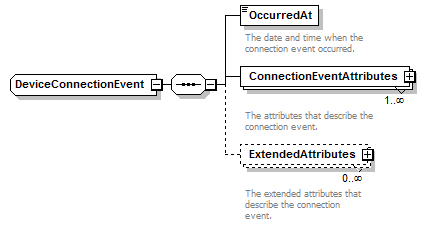 |
||
| namespace | http://nphase.com/unifiedwebservice/v2 | ||
| children | OccurredAt ConnectionEventAttributes ExtendedAttributes | ||
| used by |
|
||
| source | <xs:complexType name="DeviceConnectionEvent"> <xs:sequence> <xs:element name="OccurredAt" type="xs:dateTime"> <xs:annotation> <xs:documentation>The date and time when the connection event occurred.</xs:documentation> </xs:annotation> </xs:element> <xs:element name="ConnectionEventAttributes" type="ConnectionEventAttribute" nillable="true" maxOccurs="unbounded"> <xs:annotation> <xs:documentation>The attributes that describe the connection event.</xs:documentation> </xs:annotation> </xs:element> <xs:element name="ExtendedAttributes" type="ExtendedAttributesObj" nillable="true" minOccurs="0" maxOccurs="unbounded"> <xs:annotation> <xs:documentation>The extended attributes that describe the connection event.</xs:documentation> </xs:annotation> </xs:element> </xs:sequence> </xs:complexType> |
element DeviceConnectionEvent/OccurredAt
| diagram |  |
||
| namespace | http://nphase.com/unifiedwebservice/v2 | ||
| type | xs:dateTime | ||
| properties |
|
||
| annotation |
|
||
| source | <xs:element name="OccurredAt" type="xs:dateTime"> <xs:annotation> <xs:documentation>The date and time when the connection event occurred.</xs:documentation> </xs:annotation> </xs:element> |
element DeviceConnectionEvent/ConnectionEventAttributes
| diagram | 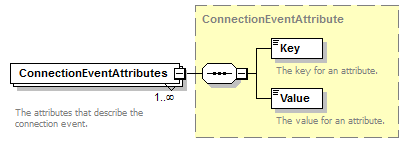 |
||||||||
| namespace | http://nphase.com/unifiedwebservice/v2 | ||||||||
| type | ConnectionEventAttribute | ||||||||
| properties |
|
||||||||
| children | Key Value | ||||||||
| annotation |
|
||||||||
| source | <xs:element name="ConnectionEventAttributes" type="ConnectionEventAttribute" nillable="true" maxOccurs="unbounded"> <xs:annotation> <xs:documentation>The attributes that describe the connection event.</xs:documentation> </xs:annotation> </xs:element> |
element DeviceConnectionEvent/ExtendedAttributes
| diagram | 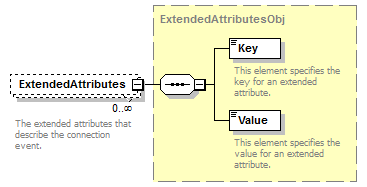 |
||||||||
| namespace | http://nphase.com/unifiedwebservice/v2 | ||||||||
| type | ExtendedAttributesObj | ||||||||
| properties |
|
||||||||
| children | Key Value | ||||||||
| annotation |
|
||||||||
| source | <xs:element name="ExtendedAttributes" type="ExtendedAttributesObj" nillable="true" minOccurs="0" maxOccurs="unbounded"> <xs:annotation> <xs:documentation>The extended attributes that describe the connection event.</xs:documentation> </xs:annotation> </xs:element> |
complexType DeviceInformation
| diagram | 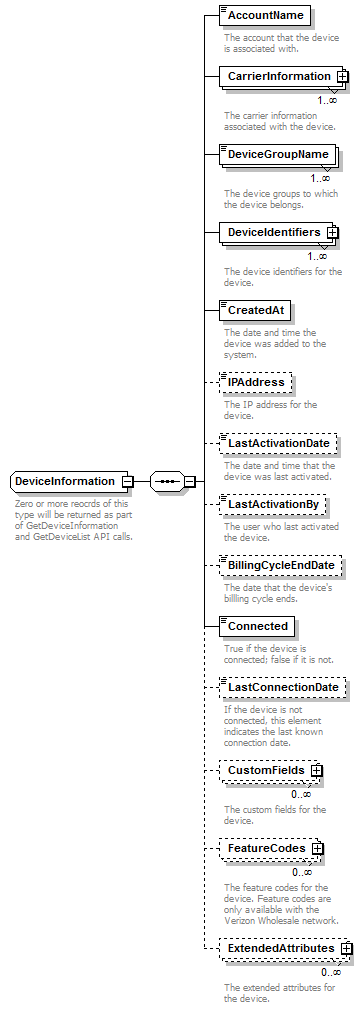 |
||
| namespace | http://nphase.com/unifiedwebservice/v2 | ||
| children | AccountName CarrierInformation DeviceGroupName DeviceIdentifiers CreatedAt IPAddress LastActivationDate LastActivationBy BillingCycleEndDate Connected LastConnectionDate CustomFields FeatureCodes ExtendedAttributes | ||
| used by |
|
||
| annotation |
|
||
| source | <xs:complexType name="DeviceInformation"> <xs:annotation> <xs:documentation>Zero or more reocrds of this type will be returned as part of GetDeviceInformation and GetDeviceList API calls.</xs:documentation> </xs:annotation> <xs:sequence> <xs:element name="AccountName" type="xs:string"> <xs:annotation> <xs:documentation>The account that the device is associated with.</xs:documentation> </xs:annotation> </xs:element> <xs:element name="CarrierInformation" type="CarrierInformation" nillable="true" maxOccurs="unbounded"> <xs:annotation> <xs:documentation>The carrier information associated with the device.</xs:documentation> </xs:annotation> </xs:element> <xs:element name="DeviceGroupName" type="xs:string" nillable="true" maxOccurs="unbounded"> <xs:annotation> <xs:documentation>The device groups to which the device belongs.</xs:documentation> </xs:annotation> </xs:element> <xs:element name="DeviceIdentifiers" type="DeviceIdentifier" maxOccurs="unbounded"> <xs:annotation> <xs:documentation>The device identifiers for the device.</xs:documentation> </xs:annotation> </xs:element> <xs:element name="CreatedAt" type="xs:dateTime"> <xs:annotation> <xs:documentation>The date and time the device was added to the system.</xs:documentation> </xs:annotation> </xs:element> <xs:element name="IPAddress" type="xs:string" nillable="true" minOccurs="0"> <xs:annotation> <xs:documentation>The IP address for the device.</xs:documentation> </xs:annotation> </xs:element> <xs:element name="LastActivationDate" type="xs:dateTime" nillable="true" minOccurs="0"> <xs:annotation> <xs:documentation>The date and time that the device was last activated.</xs:documentation> </xs:annotation> </xs:element> <xs:element name="LastActivationBy" type="xs:string" nillable="true" minOccurs="0"> <xs:annotation> <xs:documentation>The user who last activated the device.</xs:documentation> </xs:annotation> </xs:element> <xs:element name="BillingCycleEndDate" type="xs:dateTime" nillable="true" minOccurs="0"> <xs:annotation> <xs:documentation>The date that the device's billling cycle ends.</xs:documentation> </xs:annotation> </xs:element> <xs:element name="Connected" type="xs:boolean"> <xs:annotation> <xs:documentation>True if the device is connected; false if it is not.</xs:documentation> </xs:annotation> </xs:element> <xs:element name="LastConnectionDate" type="xs:dateTime" nillable="true" minOccurs="0"> <xs:annotation> <xs:documentation>If the device is not connected, this element indicates the last known connection date.</xs:documentation> </xs:annotation> </xs:element> <xs:element name="CustomFields" type="CustomFieldObj" nillable="true" minOccurs="0" maxOccurs="unbounded"> <xs:annotation> <xs:documentation>The custom fields for the device.</xs:documentation> </xs:annotation> </xs:element> <xs:element name="FeatureCodes" type="FeatureCode" nillable="true" minOccurs="0" maxOccurs="unbounded"> <xs:annotation> <xs:documentation>The feature codes for the device. Feature codes are only available with the Verizon Wholesale network.</xs:documentation> </xs:annotation> </xs:element> <xs:element name="ExtendedAttributes" type="ExtendedAttributesObj" nillable="true" minOccurs="0" maxOccurs="unbounded"> <xs:annotation> <xs:documentation>The extended attributes for the device.</xs:documentation> </xs:annotation> </xs:element> </xs:sequence> </xs:complexType> |
element DeviceInformation/AccountName
| diagram |  |
||
| namespace | http://nphase.com/unifiedwebservice/v2 | ||
| type | xs:string | ||
| properties |
|
||
| annotation |
|
||
| source | <xs:element name="AccountName" type="xs:string"> <xs:annotation> <xs:documentation>The account that the device is associated with.</xs:documentation> </xs:annotation> </xs:element> |
element DeviceInformation/CarrierInformation
| diagram | 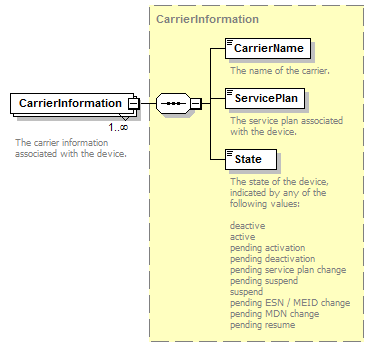 |
||||||||
| namespace | http://nphase.com/unifiedwebservice/v2 | ||||||||
| type | CarrierInformation | ||||||||
| properties |
|
||||||||
| children | CarrierName ServicePlan State | ||||||||
| annotation |
|
||||||||
| source | <xs:element name="CarrierInformation" type="CarrierInformation" nillable="true" maxOccurs="unbounded"> <xs:annotation> <xs:documentation>The carrier information associated with the device.</xs:documentation> </xs:annotation> </xs:element> |
element DeviceInformation/DeviceGroupName
| diagram |  |
||||||||
| namespace | http://nphase.com/unifiedwebservice/v2 | ||||||||
| type | xs:string | ||||||||
| properties |
|
||||||||
| annotation |
|
||||||||
| source | <xs:element name="DeviceGroupName" type="xs:string" nillable="true" maxOccurs="unbounded"> <xs:annotation> <xs:documentation>The device groups to which the device belongs.</xs:documentation> </xs:annotation> </xs:element> |
element DeviceInformation/DeviceIdentifiers
| diagram | 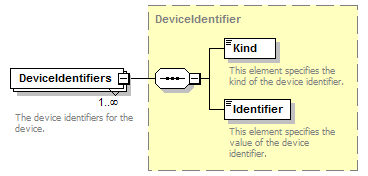 |
||||||
| namespace | http://nphase.com/unifiedwebservice/v2 | ||||||
| type | DeviceIdentifier | ||||||
| properties |
|
||||||
| children | Kind Identifier | ||||||
| annotation |
|
||||||
| source | <xs:element name="DeviceIdentifiers" type="DeviceIdentifier" maxOccurs="unbounded"> <xs:annotation> <xs:documentation>The device identifiers for the device.</xs:documentation> </xs:annotation> </xs:element> |
element DeviceInformation/CreatedAt
| diagram |  |
||
| namespace | http://nphase.com/unifiedwebservice/v2 | ||
| type | xs:dateTime | ||
| properties |
|
||
| annotation |
|
||
| source | <xs:element name="CreatedAt" type="xs:dateTime"> <xs:annotation> <xs:documentation>The date and time the device was added to the system.</xs:documentation> </xs:annotation> </xs:element> |
element DeviceInformation/IPAddress
| diagram |  |
||||||||
| namespace | http://nphase.com/unifiedwebservice/v2 | ||||||||
| type | xs:string | ||||||||
| properties |
|
||||||||
| annotation |
|
||||||||
| source | <xs:element name="IPAddress" type="xs:string" nillable="true" minOccurs="0"> <xs:annotation> <xs:documentation>The IP address for the device.</xs:documentation> </xs:annotation> </xs:element> |
element DeviceInformation/LastActivationDate
| diagram |  |
||||||||
| namespace | http://nphase.com/unifiedwebservice/v2 | ||||||||
| type | xs:dateTime | ||||||||
| properties |
|
||||||||
| annotation |
|
||||||||
| source | <xs:element name="LastActivationDate" type="xs:dateTime" nillable="true" minOccurs="0"> <xs:annotation> <xs:documentation>The date and time that the device was last activated.</xs:documentation> </xs:annotation> </xs:element> |
element DeviceInformation/LastActivationBy
| diagram |  |
||||||||
| namespace | http://nphase.com/unifiedwebservice/v2 | ||||||||
| type | xs:string | ||||||||
| properties |
|
||||||||
| annotation |
|
||||||||
| source | <xs:element name="LastActivationBy" type="xs:string" nillable="true" minOccurs="0"> <xs:annotation> <xs:documentation>The user who last activated the device.</xs:documentation> </xs:annotation> </xs:element> |
element DeviceInformation/BillingCycleEndDate
| diagram |  |
||||||||
| namespace | http://nphase.com/unifiedwebservice/v2 | ||||||||
| type | xs:dateTime | ||||||||
| properties |
|
||||||||
| annotation |
|
||||||||
| source | <xs:element name="BillingCycleEndDate" type="xs:dateTime" nillable="true" minOccurs="0"> <xs:annotation> <xs:documentation>The date that the device's billling cycle ends.</xs:documentation> </xs:annotation> </xs:element> |
element DeviceInformation/Connected
| diagram |  |
||
| namespace | http://nphase.com/unifiedwebservice/v2 | ||
| type | xs:boolean | ||
| properties |
|
||
| annotation |
|
||
| source | <xs:element name="Connected" type="xs:boolean"> <xs:annotation> <xs:documentation>True if the device is connected; false if it is not.</xs:documentation> </xs:annotation> </xs:element> |
element DeviceInformation/LastConnectionDate
| diagram |  |
||||||||
| namespace | http://nphase.com/unifiedwebservice/v2 | ||||||||
| type | xs:dateTime | ||||||||
| properties |
|
||||||||
| annotation |
|
||||||||
| source | <xs:element name="LastConnectionDate" type="xs:dateTime" nillable="true" minOccurs="0"> <xs:annotation> <xs:documentation>If the device is not connected, this element indicates the last known connection date.</xs:documentation> </xs:annotation> </xs:element> |
element DeviceInformation/CustomFields
| diagram | 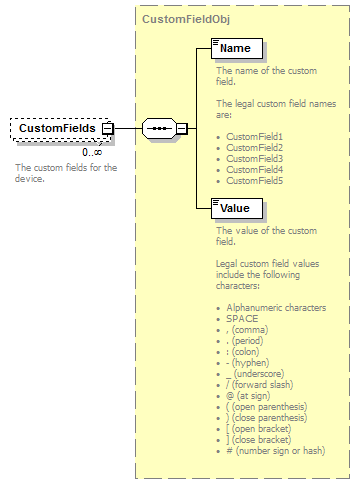 |
||||||||
| namespace | http://nphase.com/unifiedwebservice/v2 | ||||||||
| type | CustomFieldObj | ||||||||
| properties |
|
||||||||
| children | Name Value | ||||||||
| annotation |
|
||||||||
| source | <xs:element name="CustomFields" type="CustomFieldObj" nillable="true" minOccurs="0" maxOccurs="unbounded"> <xs:annotation> <xs:documentation>The custom fields for the device.</xs:documentation> </xs:annotation> </xs:element> |
element DeviceInformation/FeatureCodes
| diagram |  |
||||||||
| namespace | http://nphase.com/unifiedwebservice/v2 | ||||||||
| type | FeatureCode | ||||||||
| properties |
|
||||||||
| children | Code Description | ||||||||
| annotation |
|
||||||||
| source | <xs:element name="FeatureCodes" type="FeatureCode" nillable="true" minOccurs="0" maxOccurs="unbounded"> <xs:annotation> <xs:documentation>The feature codes for the device. Feature codes are only available with the Verizon Wholesale network.</xs:documentation> </xs:annotation> </xs:element> |
element DeviceInformation/ExtendedAttributes
| diagram | 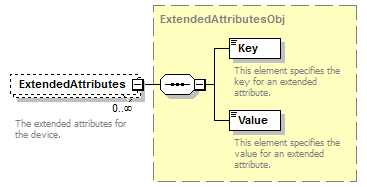 |
||||||||
| namespace | http://nphase.com/unifiedwebservice/v2 | ||||||||
| type | ExtendedAttributesObj | ||||||||
| properties |
|
||||||||
| children | Key Value | ||||||||
| annotation |
|
||||||||
| source | <xs:element name="ExtendedAttributes" type="ExtendedAttributesObj" nillable="true" minOccurs="0" maxOccurs="unbounded"> <xs:annotation> <xs:documentation>The extended attributes for the device.</xs:documentation> </xs:annotation> </xs:element> |
complexType DeviceUsage
| diagram | 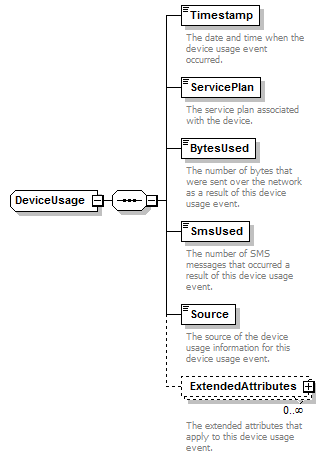 |
||
| namespace | http://nphase.com/unifiedwebservice/v2 | ||
| children | Timestamp ServicePlan BytesUsed SmsUsed Source ExtendedAttributes | ||
| used by |
|
||
| source | <xs:complexType name="DeviceUsage"> <xs:sequence> <xs:element name="Timestamp" type="xs:dateTime"> <xs:annotation> <xs:documentation>The date and time when the device usage event occurred.</xs:documentation> </xs:annotation> </xs:element> <xs:element name="ServicePlan" type="xs:string"> <xs:annotation> <xs:documentation>The service plan associated with the device.</xs:documentation> </xs:annotation> </xs:element> <xs:element name="BytesUsed" type="xs:long"> <xs:annotation> <xs:documentation>The number of bytes that were sent over the network as a result of this device usage event.</xs:documentation> </xs:annotation> </xs:element> <xs:element name="SmsUsed" type="xs:int"> <xs:annotation> <xs:documentation>The number of SMS messages that occurred a result of this device usage event.</xs:documentation> </xs:annotation> </xs:element> <xs:element name="Source" type="xs:string"> <xs:annotation> <xs:documentation>The source of the device usage information for this device usage event.</xs:documentation> </xs:annotation> </xs:element> <xs:element name="ExtendedAttributes" type="ExtendedAttributesObj" nillable="true" minOccurs="0" maxOccurs="unbounded"> <xs:annotation> <xs:documentation>The extended attributes that apply to this device usage event.</xs:documentation> </xs:annotation> </xs:element> </xs:sequence> </xs:complexType> |
element DeviceUsage/Timestamp
| diagram |  |
||
| namespace | http://nphase.com/unifiedwebservice/v2 | ||
| type | xs:dateTime | ||
| properties |
|
||
| annotation |
|
||
| source | <xs:element name="Timestamp" type="xs:dateTime"> <xs:annotation> <xs:documentation>The date and time when the device usage event occurred.</xs:documentation> </xs:annotation> </xs:element> |
element DeviceUsage/ServicePlan
| diagram |  |
||
| namespace | http://nphase.com/unifiedwebservice/v2 | ||
| type | xs:string | ||
| properties |
|
||
| annotation |
|
||
| source | <xs:element name="ServicePlan" type="xs:string"> <xs:annotation> <xs:documentation>The service plan associated with the device.</xs:documentation> </xs:annotation> </xs:element> |
element DeviceUsage/BytesUsed
| diagram |  |
||
| namespace | http://nphase.com/unifiedwebservice/v2 | ||
| type | xs:long | ||
| properties |
|
||
| annotation |
|
||
| source | <xs:element name="BytesUsed" type="xs:long"> <xs:annotation> <xs:documentation>The number of bytes that were sent over the network as a result of this device usage event.</xs:documentation> </xs:annotation> </xs:element> |
element DeviceUsage/SmsUsed
| diagram |  |
||
| namespace | http://nphase.com/unifiedwebservice/v2 | ||
| type | xs:int | ||
| properties |
|
||
| annotation |
|
||
| source | <xs:element name="SmsUsed" type="xs:int"> <xs:annotation> <xs:documentation>The number of SMS messages that occurred a result of this device usage event.</xs:documentation> </xs:annotation> </xs:element> |
element DeviceUsage/Source
| diagram |  |
||
| namespace | http://nphase.com/unifiedwebservice/v2 | ||
| type | xs:string | ||
| properties |
|
||
| annotation |
|
||
| source | <xs:element name="Source" type="xs:string"> <xs:annotation> <xs:documentation>The source of the device usage information for this device usage event.</xs:documentation> </xs:annotation> </xs:element> |
element DeviceUsage/ExtendedAttributes
| diagram | 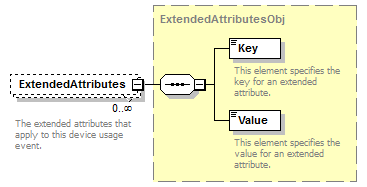 |
||||||||
| namespace | http://nphase.com/unifiedwebservice/v2 | ||||||||
| type | ExtendedAttributesObj | ||||||||
| properties |
|
||||||||
| children | Key Value | ||||||||
| annotation |
|
||||||||
| source | <xs:element name="ExtendedAttributes" type="ExtendedAttributesObj" nillable="true" minOccurs="0" maxOccurs="unbounded"> <xs:annotation> <xs:documentation>The extended attributes that apply to this device usage event.</xs:documentation> </xs:annotation> </xs:element> |
complexType Messages
| diagram | 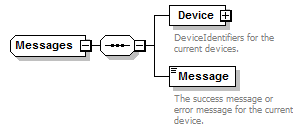 |
||
| namespace | http://nphase.com/unifiedwebservice/v2 | ||
| children | Device Message | ||
| used by |
|
||
| source | <xs:complexType name="Messages"> <xs:sequence> <xs:element name="Device" type="DeviceIdentifierCollection"> <xs:annotation> <xs:documentation>DeviceIdentifiers for the current devices.</xs:documentation> </xs:annotation> </xs:element> <xs:element name="Message" type="xs:string"> <xs:annotation> <xs:documentation>The success message or error message for the current device.</xs:documentation> </xs:annotation> </xs:element> </xs:sequence> </xs:complexType> |
element Messages/Device
| diagram |  |
||
| namespace | http://nphase.com/unifiedwebservice/v2 | ||
| type | DeviceIdentifierCollection | ||
| properties |
|
||
| children | DeviceIdentifiers | ||
| annotation |
|
||
| source | <xs:element name="Device" type="DeviceIdentifierCollection"> <xs:annotation> <xs:documentation>DeviceIdentifiers for the current devices.</xs:documentation> </xs:annotation> </xs:element> |
element Messages/Message
| diagram |  |
||
| namespace | http://nphase.com/unifiedwebservice/v2 | ||
| type | xs:string | ||
| properties |
|
||
| annotation |
|
||
| source | <xs:element name="Message" type="xs:string"> <xs:annotation> <xs:documentation>The success message or error message for the current device.</xs:documentation> </xs:annotation> </xs:element> |
complexType ProvisioningEvent
| diagram | 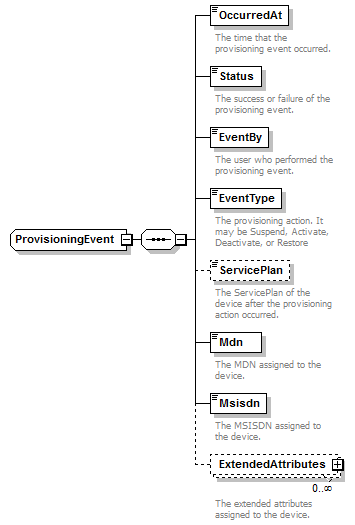 |
||
| namespace | http://nphase.com/unifiedwebservice/v2 | ||
| children | OccurredAt Status EventBy EventType ServicePlan Mdn Msisdn ExtendedAttributes | ||
| used by |
|
||
| source | <xs:complexType name="ProvisioningEvent"> <xs:sequence> <xs:element name="OccurredAt" type="xs:dateTime"> <xs:annotation> <xs:documentation>The time that the provisioning event occurred.</xs:documentation> </xs:annotation> </xs:element> <xs:element name="Status" type="xs:string"> <xs:annotation> <xs:documentation>The success or failure of the provisioning event.</xs:documentation> </xs:annotation> </xs:element> <xs:element name="EventBy" type="xs:string"> <xs:annotation> <xs:documentation>The user who performed the provisioning event.</xs:documentation> </xs:annotation> </xs:element> <xs:element name="EventType" type="xs:string"> <xs:annotation> <xs:documentation>The provisioning action. It may be Suspend, Activate, Deactivate, or Restore</xs:documentation> </xs:annotation> </xs:element> <xs:element name="ServicePlan" type="xs:string" nillable="true" minOccurs="0"> <xs:annotation> <xs:documentation>The ServicePlan of the device after the provisioning action occurred.</xs:documentation> </xs:annotation> </xs:element> <xs:element name="Mdn" type="xs:string"> <xs:annotation> <xs:documentation>The MDN assigned to the device.</xs:documentation> </xs:annotation> </xs:element> <xs:element name="Msisdn" type="xs:string"> <xs:annotation> <xs:documentation>The MSISDN assigned to the device.</xs:documentation> </xs:annotation> </xs:element> <xs:element name="ExtendedAttributes" type="ExtendedAttributesObj" nillable="true" minOccurs="0" maxOccurs="unbounded"> <xs:annotation> <xs:documentation>The extended attributes assigned to the device. </xs:documentation> </xs:annotation> </xs:element> </xs:sequence> </xs:complexType> |
element ProvisioningEvent/OccurredAt
| diagram |  |
||
| namespace | http://nphase.com/unifiedwebservice/v2 | ||
| type | xs:dateTime | ||
| properties |
|
||
| annotation |
|
||
| source | <xs:element name="OccurredAt" type="xs:dateTime"> <xs:annotation> <xs:documentation>The time that the provisioning event occurred.</xs:documentation> </xs:annotation> </xs:element> |
element ProvisioningEvent/Status
| diagram |  |
||
| namespace | http://nphase.com/unifiedwebservice/v2 | ||
| type | xs:string | ||
| properties |
|
||
| annotation |
|
||
| source | <xs:element name="Status" type="xs:string"> <xs:annotation> <xs:documentation>The success or failure of the provisioning event.</xs:documentation> </xs:annotation> </xs:element> |
element ProvisioningEvent/EventBy
| diagram |  |
||
| namespace | http://nphase.com/unifiedwebservice/v2 | ||
| type | xs:string | ||
| properties |
|
||
| annotation |
|
||
| source | <xs:element name="EventBy" type="xs:string"> <xs:annotation> <xs:documentation>The user who performed the provisioning event.</xs:documentation> </xs:annotation> </xs:element> |
element ProvisioningEvent/EventType
| diagram |  |
||
| namespace | http://nphase.com/unifiedwebservice/v2 | ||
| type | xs:string | ||
| properties |
|
||
| annotation |
|
||
| source | <xs:element name="EventType" type="xs:string"> <xs:annotation> <xs:documentation>The provisioning action. It may be Suspend, Activate, Deactivate, or Restore</xs:documentation> </xs:annotation> </xs:element> |
element ProvisioningEvent/ServicePlan
| diagram |  |
||||||||
| namespace | http://nphase.com/unifiedwebservice/v2 | ||||||||
| type | xs:string | ||||||||
| properties |
|
||||||||
| annotation |
|
||||||||
| source | <xs:element name="ServicePlan" type="xs:string" nillable="true" minOccurs="0"> <xs:annotation> <xs:documentation>The ServicePlan of the device after the provisioning action occurred.</xs:documentation> </xs:annotation> </xs:element> |
element ProvisioningEvent/Mdn
| diagram |  |
||
| namespace | http://nphase.com/unifiedwebservice/v2 | ||
| type | xs:string | ||
| properties |
|
||
| annotation |
|
||
| source | <xs:element name="Mdn" type="xs:string"> <xs:annotation> <xs:documentation>The MDN assigned to the device.</xs:documentation> </xs:annotation> </xs:element> |
element ProvisioningEvent/Msisdn
| diagram |  |
||
| namespace | http://nphase.com/unifiedwebservice/v2 | ||
| type | xs:string | ||
| properties |
|
||
| annotation |
|
||
| source | <xs:element name="Msisdn" type="xs:string"> <xs:annotation> <xs:documentation>The MSISDN assigned to the device.</xs:documentation> </xs:annotation> </xs:element> |
element ProvisioningEvent/ExtendedAttributes
| diagram | 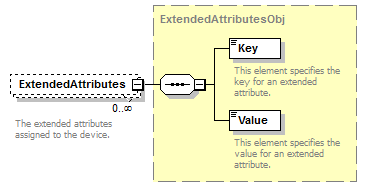 |
||||||||
| namespace | http://nphase.com/unifiedwebservice/v2 | ||||||||
| type | ExtendedAttributesObj | ||||||||
| properties |
|
||||||||
| children | Key Value | ||||||||
| annotation |
|
||||||||
| source | <xs:element name="ExtendedAttributes" type="ExtendedAttributesObj" nillable="true" minOccurs="0" maxOccurs="unbounded"> <xs:annotation> <xs:documentation>The extended attributes assigned to the device. </xs:documentation> </xs:annotation> </xs:element> |
complexType CustomFieldFilterObj
| diagram | 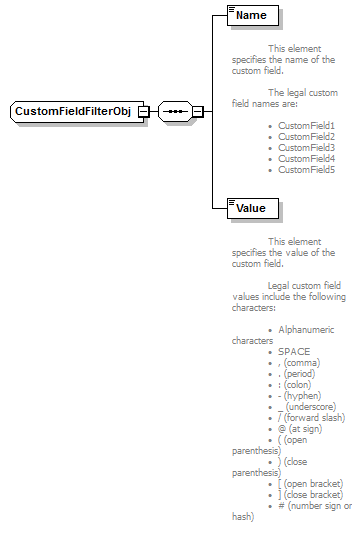 |
||
| namespace | http://nphase.com/unifiedwebservice/v2 | ||
| children | Name Value | ||
| used by |
|
||
| source | <xs:complexType name="CustomFieldFilterObj"> <xs:sequence> <xs:element name="Name" type="xs:string"> <xs:annotation> <xs:documentation> This element specifies the name of the custom field. The legal custom field names are: • CustomField1 • CustomField2 • CustomField3 • CustomField4 • CustomField5 </xs:documentation> </xs:annotation> </xs:element> <xs:element name="Value" type="xs:string"> <xs:annotation> <xs:documentation> This element specifies the value of the custom field. Legal custom field values include the following characters: • Alphanumeric characters • SPACE • , (comma) • . (period) • : (colon) • - (hyphen) • _ (underscore) • / (forward slash) • @ (at sign) • ( (open parenthesis) • ) (close parenthesis) • [ (open bracket) • ] (close bracket) • # (number sign or hash) </xs:documentation> </xs:annotation> </xs:element> </xs:sequence> </xs:complexType> |
element CustomFieldFilterObj/Name
| diagram | 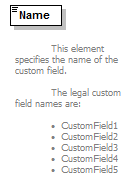 |
||
| namespace | http://nphase.com/unifiedwebservice/v2 | ||
| type | xs:string | ||
| properties |
|
||
| annotation |
|
||
| source | <xs:element name="Name" type="xs:string"> <xs:annotation> <xs:documentation> This element specifies the name of the custom field. The legal custom field names are: • CustomField1 • CustomField2 • CustomField3 • CustomField4 • CustomField5 </xs:documentation> </xs:annotation> </xs:element> |
element CustomFieldFilterObj/Value
| diagram | 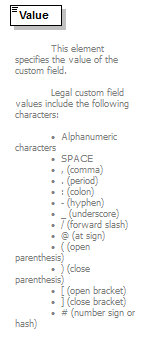 |
||
| namespace | http://nphase.com/unifiedwebservice/v2 | ||
| type | xs:string | ||
| properties |
|
||
| annotation |
|
||
| source | <xs:element name="Value" type="xs:string"> <xs:annotation> <xs:documentation> This element specifies the value of the custom field. Legal custom field values include the following characters: • Alphanumeric characters • SPACE • , (comma) • . (period) • : (colon) • - (hyphen) • _ (underscore) • / (forward slash) • @ (at sign) • ( (open parenthesis) • ) (close parenthesis) • [ (open bracket) • ] (close bracket) • # (number sign or hash) </xs:documentation> </xs:annotation> </xs:element> |
complexType Date
| diagram |  |
| namespace | http://nphase.com/unifiedwebservice/v2 |
| children | Month Day Year |
| source | <xs:complexType name="Date"> <xs:sequence> <xs:element name="Month" type="xs:unsignedByte"/> <xs:element name="Day" type="xs:unsignedByte"/> <xs:element name="Year" type="xs:unsignedShort"/> </xs:sequence> </xs:complexType> |
element Date/Month
| diagram |  |
||
| namespace | http://nphase.com/unifiedwebservice/v2 | ||
| type | xs:unsignedByte | ||
| properties |
|
||
| source | <xs:element name="Month" type="xs:unsignedByte"/> |
element Date/Day
| diagram |  |
||
| namespace | http://nphase.com/unifiedwebservice/v2 | ||
| type | xs:unsignedByte | ||
| properties |
|
||
| source | <xs:element name="Day" type="xs:unsignedByte"/> |
element Date/Year
| diagram |  |
||
| namespace | http://nphase.com/unifiedwebservice/v2 | ||
| type | xs:unsignedShort | ||
| properties |
|
||
| source | <xs:element name="Year" type="xs:unsignedShort"/> |
complexType DeviceIdentifier
| diagram | 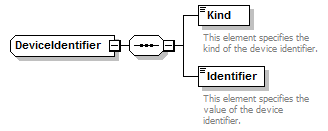 |
| namespace | http://nphase.com/unifiedwebservice/v2 |
| children | Kind Identifier |
| used by | |
| source | <xs:complexType name="DeviceIdentifier"> <xs:sequence> <xs:element name="Kind"> <xs:annotation> <xs:documentation>This element specifies the kind of the device identifier.</xs:documentation> </xs:annotation> <xs:simpleType> <xs:restriction base="xs:string"> <xs:enumeration value="Esn"> <xs:annotation> <xs:documentation>Electronic Serial Number (8-digit hexadecimal or 11-digit decimal format).</xs:documentation> </xs:annotation> </xs:enumeration> <xs:enumeration value="Iccid"> <xs:annotation> <xs:documentation>Integrated Circuit Card ID (used with a SIM card).</xs:documentation> </xs:annotation> </xs:enumeration> <xs:enumeration value="Imsi"> <xs:annotation> <xs:documentation>International Mobile Subscriber Identity</xs:documentation> </xs:annotation> </xs:enumeration> <xs:enumeration value="Mdn"> <xs:annotation> <xs:documentation>Mobile Directory Number</xs:documentation> </xs:annotation> </xs:enumeration> <xs:enumeration value="Meid"> <xs:annotation> <xs:documentation>Mobile Equipment Identifier</xs:documentation> </xs:annotation> </xs:enumeration> <xs:enumeration value="Imei"> <xs:annotation> <xs:documentation>International Mobile Station Equipment Identity</xs:documentation> </xs:annotation> </xs:enumeration> <xs:enumeration value="Msisdn"> <xs:annotation> <xs:documentation>Mobile Subscriber Integrated Services Digital Network-Number</xs:documentation> </xs:annotation> </xs:enumeration> </xs:restriction> </xs:simpleType> </xs:element> <xs:element name="Identifier" type="xs:string"> <xs:annotation> <xs:documentation>This element specifies the value of the device identifier.</xs:documentation> </xs:annotation> </xs:element> </xs:sequence> </xs:complexType> |
element DeviceIdentifier/Kind
| diagram |  |
||||||||||||||||||||||||||||||||||||||
| namespace | http://nphase.com/unifiedwebservice/v2 | ||||||||||||||||||||||||||||||||||||||
| type | restriction of xs:string | ||||||||||||||||||||||||||||||||||||||
| properties |
|
||||||||||||||||||||||||||||||||||||||
| facets |
|
||||||||||||||||||||||||||||||||||||||
| annotation |
|
||||||||||||||||||||||||||||||||||||||
| source | <xs:element name="Kind"> <xs:annotation> <xs:documentation>This element specifies the kind of the device identifier.</xs:documentation> </xs:annotation> <xs:simpleType> <xs:restriction base="xs:string"> <xs:enumeration value="Esn"> <xs:annotation> <xs:documentation>Electronic Serial Number (8-digit hexadecimal or 11-digit decimal format).</xs:documentation> </xs:annotation> </xs:enumeration> <xs:enumeration value="Iccid"> <xs:annotation> <xs:documentation>Integrated Circuit Card ID (used with a SIM card).</xs:documentation> </xs:annotation> </xs:enumeration> <xs:enumeration value="Imsi"> <xs:annotation> <xs:documentation>International Mobile Subscriber Identity</xs:documentation> </xs:annotation> </xs:enumeration> <xs:enumeration value="Mdn"> <xs:annotation> <xs:documentation>Mobile Directory Number</xs:documentation> </xs:annotation> </xs:enumeration> <xs:enumeration value="Meid"> <xs:annotation> <xs:documentation>Mobile Equipment Identifier</xs:documentation> </xs:annotation> </xs:enumeration> <xs:enumeration value="Imei"> <xs:annotation> <xs:documentation>International Mobile Station Equipment Identity</xs:documentation> </xs:annotation> </xs:enumeration> <xs:enumeration value="Msisdn"> <xs:annotation> <xs:documentation>Mobile Subscriber Integrated Services Digital Network-Number</xs:documentation> </xs:annotation> </xs:enumeration> </xs:restriction> </xs:simpleType> </xs:element> |
element DeviceIdentifier/Identifier
| diagram |  |
||
| namespace | http://nphase.com/unifiedwebservice/v2 | ||
| type | xs:string | ||
| properties |
|
||
| annotation |
|
||
| source | <xs:element name="Identifier" type="xs:string"> <xs:annotation> <xs:documentation>This element specifies the value of the device identifier.</xs:documentation> </xs:annotation> </xs:element> |
complexType DeviceIdentifierCollection
| diagram |  |
||
| namespace | http://nphase.com/unifiedwebservice/v2 | ||
| children | DeviceIdentifiers | ||
| used by |
|
||
| annotation |
|
||
| source | <xs:complexType name="DeviceIdentifierCollection"> <xs:annotation> <xs:documentation>Collection of all the identifiers assigned to the device.</xs:documentation> </xs:annotation> <xs:sequence> <xs:element name="DeviceIdentifiers" type="DeviceIdentifier" nillable="true" minOccurs="1" maxOccurs="unbounded"/> </xs:sequence> </xs:complexType> |
element DeviceIdentifierCollection/DeviceIdentifiers
| diagram | 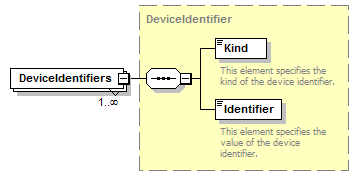 |
||||||||
| namespace | http://nphase.com/unifiedwebservice/v2 | ||||||||
| type | DeviceIdentifier | ||||||||
| properties |
|
||||||||
| children | Kind Identifier | ||||||||
| source | <xs:element name="DeviceIdentifiers" type="DeviceIdentifier" nillable="true" minOccurs="1" maxOccurs="unbounded"/> |
complexType ErrorInformation
| diagram | 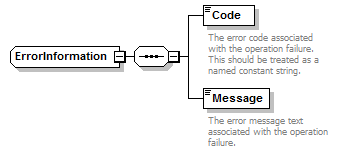 |
| namespace | http://nphase.com/unifiedwebservice/v2 |
| children | Code Message |
| source | <xs:complexType name="ErrorInformation"> <xs:sequence> <xs:element name="Code" type="xs:string"> <xs:annotation> <xs:documentation>The error code associated with the operation failure. This should be treated as a named constant string.</xs:documentation> </xs:annotation> </xs:element> <xs:element name="Message" type="xs:string"> <xs:annotation> <xs:documentation>The error message text associated with the operation failure.</xs:documentation> </xs:annotation> </xs:element> </xs:sequence> </xs:complexType> |
element ErrorInformation/Code
| diagram |  |
||
| namespace | http://nphase.com/unifiedwebservice/v2 | ||
| type | xs:string | ||
| properties |
|
||
| annotation |
|
||
| source | <xs:element name="Code" type="xs:string"> <xs:annotation> <xs:documentation>The error code associated with the operation failure. This should be treated as a named constant string.</xs:documentation> </xs:annotation> </xs:element> |
element ErrorInformation/Message
| diagram |  |
||
| namespace | http://nphase.com/unifiedwebservice/v2 | ||
| type | xs:string | ||
| properties |
|
||
| annotation |
|
||
| source | <xs:element name="Message" type="xs:string"> <xs:annotation> <xs:documentation>The error message text associated with the operation failure.</xs:documentation> </xs:annotation> </xs:element> |
complexType ExtendedAttributesObj
| diagram | 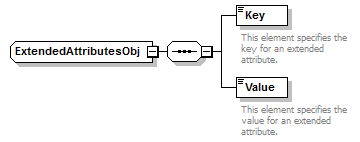 |
||
| namespace | http://nphase.com/unifiedwebservice/v2 | ||
| children | Key Value | ||
| used by |
|
||
| source | <xs:complexType name="ExtendedAttributesObj"> <xs:sequence> <xs:element name="Key" type="xs:string" nillable="true"> <xs:annotation> <xs:documentation>This element specifies the key for an extended attribute.</xs:documentation> </xs:annotation> </xs:element> <xs:element name="Value" type="xs:string" nillable="true"> <xs:annotation> <xs:documentation>This element specifies the value for an extended attribute.</xs:documentation> </xs:annotation> </xs:element> </xs:sequence> </xs:complexType> |
element ExtendedAttributesObj/Key
| diagram |  |
||||
| namespace | http://nphase.com/unifiedwebservice/v2 | ||||
| type | xs:string | ||||
| properties |
|
||||
| annotation |
|
||||
| source | <xs:element name="Key" type="xs:string" nillable="true"> <xs:annotation> <xs:documentation>This element specifies the key for an extended attribute.</xs:documentation> </xs:annotation> </xs:element> |
element ExtendedAttributesObj/Value
| diagram |  |
||||
| namespace | http://nphase.com/unifiedwebservice/v2 | ||||
| type | xs:string | ||||
| properties |
|
||||
| annotation |
|
||||
| source | <xs:element name="Value" type="xs:string" nillable="true"> <xs:annotation> <xs:documentation>This element specifies the value for an extended attribute.</xs:documentation> </xs:annotation> </xs:element> |
complexType FeatureCode
| diagram |  |
||
| namespace | http://nphase.com/unifiedwebservice/v2 | ||
| children | Code Description | ||
| used by |
|
||
| source | <xs:complexType name="FeatureCode"> <xs:sequence> <xs:element name="Code" type="xs:string" nillable="true"/> <xs:element name="Description" type="xs:string" nillable="true"/> </xs:sequence> </xs:complexType> |
element FeatureCode/Code
| diagram |  |
||||
| namespace | http://nphase.com/unifiedwebservice/v2 | ||||
| type | xs:string | ||||
| properties |
|
||||
| source | <xs:element name="Code" type="xs:string" nillable="true"/> |
element FeatureCode/Description
| diagram |  |
||||
| namespace | http://nphase.com/unifiedwebservice/v2 | ||||
| type | xs:string | ||||
| properties |
|
||||
| source | <xs:element name="Description" type="xs:string" nillable="true"/> |
complexType InclusiveDateTimeRange
| diagram | 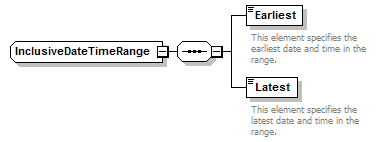 |
||
| namespace | http://nphase.com/unifiedwebservice/v2 | ||
| children | Earliest Latest | ||
| used by |
|
||
| source | <xs:complexType name="InclusiveDateTimeRange"> <xs:sequence> <xs:element name="Earliest" type="xs:dateTime"> <xs:annotation> <xs:documentation>This element specifies the earliest date and time in the range.</xs:documentation> </xs:annotation> </xs:element> <xs:element name="Latest" type="xs:dateTime"> <xs:annotation> <xs:documentation>This element specifies the latest date and time in the range.</xs:documentation> </xs:annotation> </xs:element> </xs:sequence> </xs:complexType> |
element InclusiveDateTimeRange/Earliest
| diagram |  |
||
| namespace | http://nphase.com/unifiedwebservice/v2 | ||
| type | xs:dateTime | ||
| properties |
|
||
| annotation |
|
||
| source | <xs:element name="Earliest" type="xs:dateTime"> <xs:annotation> <xs:documentation>This element specifies the earliest date and time in the range.</xs:documentation> </xs:annotation> </xs:element> |
element InclusiveDateTimeRange/Latest
| diagram |  |
||
| namespace | http://nphase.com/unifiedwebservice/v2 | ||
| type | xs:dateTime | ||
| properties |
|
||
| annotation |
|
||
| source | <xs:element name="Latest" type="xs:dateTime"> <xs:annotation> <xs:documentation>This element specifies the latest date and time in the range.</xs:documentation> </xs:annotation> </xs:element> |
complexType PrimaryPlaceOfUse
| diagram |  |
| namespace | http://nphase.com/unifiedwebservice/v2 |
| children | CustomerName Address |
| source | <xs:complexType name="PrimaryPlaceOfUse"> <xs:sequence> <xs:element name="CustomerName" type="PrimaryPlaceOfUseCustomerName" nillable="true"/> <xs:element name="Address" type="PrimaryPlaceOfUseAddress" nillable="true"/> </xs:sequence> </xs:complexType> |
element PrimaryPlaceOfUse/CustomerName
| diagram |  |
||||
| namespace | http://nphase.com/unifiedwebservice/v2 | ||||
| type | PrimaryPlaceOfUseCustomerName | ||||
| properties |
|
||||
| children | Title FirstName MiddleName LastName Suffix | ||||
| source | <xs:element name="CustomerName" type="PrimaryPlaceOfUseCustomerName" nillable="true"/> |
element PrimaryPlaceOfUse/Address
| diagram | 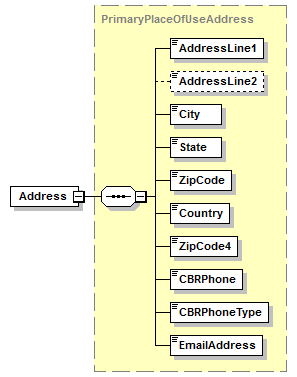 |
||||
| namespace | http://nphase.com/unifiedwebservice/v2 | ||||
| type | PrimaryPlaceOfUseAddress | ||||
| properties |
|
||||
| children | AddressLine1 AddressLine2 City State ZipCode Country ZipCode4 CBRPhone CBRPhoneType EmailAddress | ||||
| source | <xs:element name="Address" type="PrimaryPlaceOfUseAddress" nillable="true"/> |
complexType PrimaryPlaceOfUseAddress
| diagram | 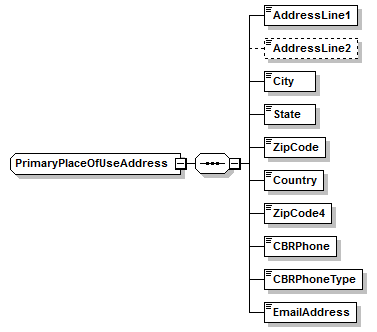 |
||
| namespace | http://nphase.com/unifiedwebservice/v2 | ||
| children | AddressLine1 AddressLine2 City State ZipCode Country ZipCode4 CBRPhone CBRPhoneType EmailAddress | ||
| used by |
|
||
| source | <xs:complexType name="PrimaryPlaceOfUseAddress"> <xs:sequence> <xs:element name="AddressLine1" type="xs:string" nillable="true"/> <xs:element name="AddressLine2" type="xs:string" nillable="true" minOccurs="0"/> <xs:element name="City" type="xs:string" nillable="true"/> <xs:element name="State" type="xs:string" nillable="true"/> <xs:element name="ZipCode" type="xs:string" nillable="true"/> <xs:element name="Country" type="xs:string" nillable="true"/> <xs:element name="ZipCode4" type="xs:string" nillable="true"/> <xs:element name="CBRPhone" type="xs:string" nillable="true"/> <xs:element name="CBRPhoneType" type="xs:string" nillable="true"/> <xs:element name="EmailAddress" type="xs:string" nillable="true"/> </xs:sequence> </xs:complexType> |
element PrimaryPlaceOfUseAddress/AddressLine1
| diagram |  |
||||
| namespace | http://nphase.com/unifiedwebservice/v2 | ||||
| type | xs:string | ||||
| properties |
|
||||
| source | <xs:element name="AddressLine1" type="xs:string" nillable="true"/> |
element PrimaryPlaceOfUseAddress/AddressLine2
| diagram |  |
||||||||
| namespace | http://nphase.com/unifiedwebservice/v2 | ||||||||
| type | xs:string | ||||||||
| properties |
|
||||||||
| source | <xs:element name="AddressLine2" type="xs:string" nillable="true" minOccurs="0"/> |
element PrimaryPlaceOfUseAddress/City
| diagram |  |
||||
| namespace | http://nphase.com/unifiedwebservice/v2 | ||||
| type | xs:string | ||||
| properties |
|
||||
| source | <xs:element name="City" type="xs:string" nillable="true"/> |
element PrimaryPlaceOfUseAddress/State
| diagram |  |
||||
| namespace | http://nphase.com/unifiedwebservice/v2 | ||||
| type | xs:string | ||||
| properties |
|
||||
| source | <xs:element name="State" type="xs:string" nillable="true"/> |
element PrimaryPlaceOfUseAddress/ZipCode
| diagram |  |
||||
| namespace | http://nphase.com/unifiedwebservice/v2 | ||||
| type | xs:string | ||||
| properties |
|
||||
| source | <xs:element name="ZipCode" type="xs:string" nillable="true"/> |
element PrimaryPlaceOfUseAddress/Country
| diagram |  |
||||
| namespace | http://nphase.com/unifiedwebservice/v2 | ||||
| type | xs:string | ||||
| properties |
|
||||
| source | <xs:element name="Country" type="xs:string" nillable="true"/> |
element PrimaryPlaceOfUseAddress/ZipCode4
| diagram |  |
||||
| namespace | http://nphase.com/unifiedwebservice/v2 | ||||
| type | xs:string | ||||
| properties |
|
||||
| source | <xs:element name="ZipCode4" type="xs:string" nillable="true"/> |
element PrimaryPlaceOfUseAddress/CBRPhone
| diagram |  |
||||
| namespace | http://nphase.com/unifiedwebservice/v2 | ||||
| type | xs:string | ||||
| properties |
|
||||
| source | <xs:element name="CBRPhone" type="xs:string" nillable="true"/> |
element PrimaryPlaceOfUseAddress/CBRPhoneType
| diagram |  |
||||
| namespace | http://nphase.com/unifiedwebservice/v2 | ||||
| type | xs:string | ||||
| properties |
|
||||
| source | <xs:element name="CBRPhoneType" type="xs:string" nillable="true"/> |
element PrimaryPlaceOfUseAddress/EmailAddress
| diagram |  |
||||
| namespace | http://nphase.com/unifiedwebservice/v2 | ||||
| type | xs:string | ||||
| properties |
|
||||
| source | <xs:element name="EmailAddress" type="xs:string" nillable="true"/> |
complexType PrimaryPlaceOfUseCustomerName
| diagram | 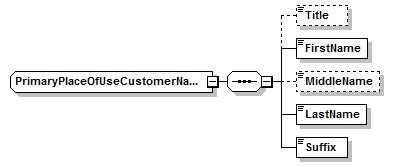 |
||
| namespace | http://nphase.com/unifiedwebservice/v2 | ||
| children | Title FirstName MiddleName LastName Suffix | ||
| used by |
|
||
| source | <xs:complexType name="PrimaryPlaceOfUseCustomerName"> <xs:sequence> <xs:element name="Title" type="xs:string" nillable="true" minOccurs="0"/> <xs:element name="FirstName" type="xs:string" nillable="true"/> <xs:element name="MiddleName" type="xs:string" nillable="true" minOccurs="0"/> <xs:element name="LastName" type="xs:string" nillable="true"/> <xs:element name="Suffix" type="xs:string" nillable="true"/> </xs:sequence> </xs:complexType> |
element PrimaryPlaceOfUseCustomerName/Title
| diagram |  |
||||||||
| namespace | http://nphase.com/unifiedwebservice/v2 | ||||||||
| type | xs:string | ||||||||
| properties |
|
||||||||
| source | <xs:element name="Title" type="xs:string" nillable="true" minOccurs="0"/> |
element PrimaryPlaceOfUseCustomerName/FirstName
| diagram |  |
||||
| namespace | http://nphase.com/unifiedwebservice/v2 | ||||
| type | xs:string | ||||
| properties |
|
||||
| source | <xs:element name="FirstName" type="xs:string" nillable="true"/> |
element PrimaryPlaceOfUseCustomerName/MiddleName
| diagram |  |
||||||||
| namespace | http://nphase.com/unifiedwebservice/v2 | ||||||||
| type | xs:string | ||||||||
| properties |
|
||||||||
| source | <xs:element name="MiddleName" type="xs:string" nillable="true" minOccurs="0"/> |
element PrimaryPlaceOfUseCustomerName/LastName
| diagram |  |
||||
| namespace | http://nphase.com/unifiedwebservice/v2 | ||||
| type | xs:string | ||||
| properties |
|
||||
| source | <xs:element name="LastName" type="xs:string" nillable="true"/> |
element PrimaryPlaceOfUseCustomerName/Suffix
| diagram |  |
||||
| namespace | http://nphase.com/unifiedwebservice/v2 | ||||
| type | xs:string | ||||
| properties |
|
||||
| source | <xs:element name="Suffix" type="xs:string" nillable="true"/> |
complexType Time
| diagram | 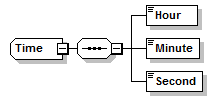 |
||
| namespace | http://nphase.com/unifiedwebservice/v2 | ||
| children | Hour Minute Second | ||
| used by |
|
||
| source | <xs:complexType name="Time"> <xs:sequence> <xs:element name="Hour" type="xs:unsignedByte"/> <xs:element name="Minute" type="xs:unsignedByte"/> <xs:element name="Second" type="xs:unsignedByte"/> </xs:sequence> </xs:complexType> |
element Time/Hour
| diagram |  |
||
| namespace | http://nphase.com/unifiedwebservice/v2 | ||
| type | xs:unsignedByte | ||
| properties |
|
||
| source | <xs:element name="Hour" type="xs:unsignedByte"/> |
element Time/Minute
| diagram |  |
||
| namespace | http://nphase.com/unifiedwebservice/v2 | ||
| type | xs:unsignedByte | ||
| properties |
|
||
| source | <xs:element name="Minute" type="xs:unsignedByte"/> |
element Time/Second
| diagram |  |
||
| namespace | http://nphase.com/unifiedwebservice/v2 | ||
| type | xs:unsignedByte | ||
| properties |
|
||
| source | <xs:element name="Second" type="xs:unsignedByte"/> |
complexType TimeRange
| diagram |  |
||
| namespace | http://nphase.com/unifiedwebservice/v2 | ||
| children | Start End | ||
| used by |
|
||
| source | <xs:complexType name="TimeRange"> <xs:sequence> <xs:element name="Start" type="xs:dateTime"/> <xs:element name="End" type="xs:dateTime"/> </xs:sequence> </xs:complexType> |
element TimeRange/Start
| diagram |  |
||
| namespace | http://nphase.com/unifiedwebservice/v2 | ||
| type | xs:dateTime | ||
| properties |
|
||
| source | <xs:element name="Start" type="xs:dateTime"/> |
element TimeRange/End
| diagram |  |
||
| namespace | http://nphase.com/unifiedwebservice/v2 | ||
| type | xs:dateTime | ||
| properties |
|
||
| source | <xs:element name="End" type="xs:dateTime"/> |
complexType TimeRangePerDay
| diagram |  |
| namespace | http://nphase.com/unifiedwebservice/v2 |
| children | Start End |
| source | <xs:complexType name="TimeRangePerDay"> <xs:sequence> <xs:element name="Start" type="Time"/> <xs:element name="End" type="Time"/> </xs:sequence> </xs:complexType> |
element TimeRangePerDay/Start
| diagram | 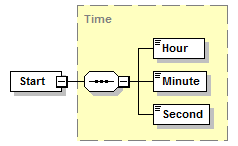 |
||
| namespace | http://nphase.com/unifiedwebservice/v2 | ||
| type | Time | ||
| properties |
|
||
| children | Hour Minute Second | ||
| source | <xs:element name="Start" type="Time"/> |
element TimeRangePerDay/End
| diagram |  |
||
| namespace | http://nphase.com/unifiedwebservice/v2 | ||
| type | Time | ||
| properties |
|
||
| children | Hour Minute Second | ||
| source | <xs:element name="End" type="Time"/> |
XML Schema documentation generated by XMLSpy Schema Editor http://www.altova.com/xmlspy